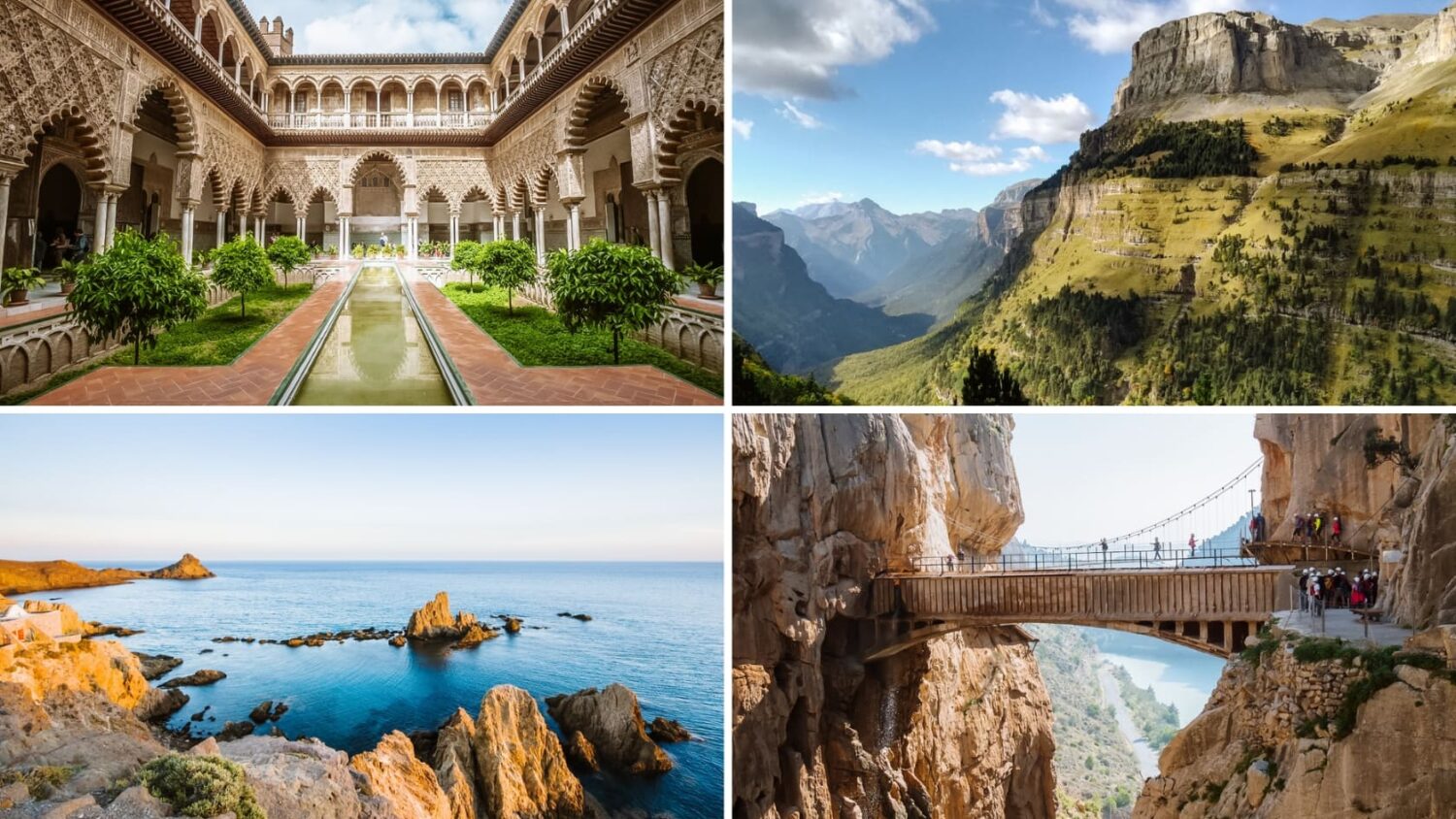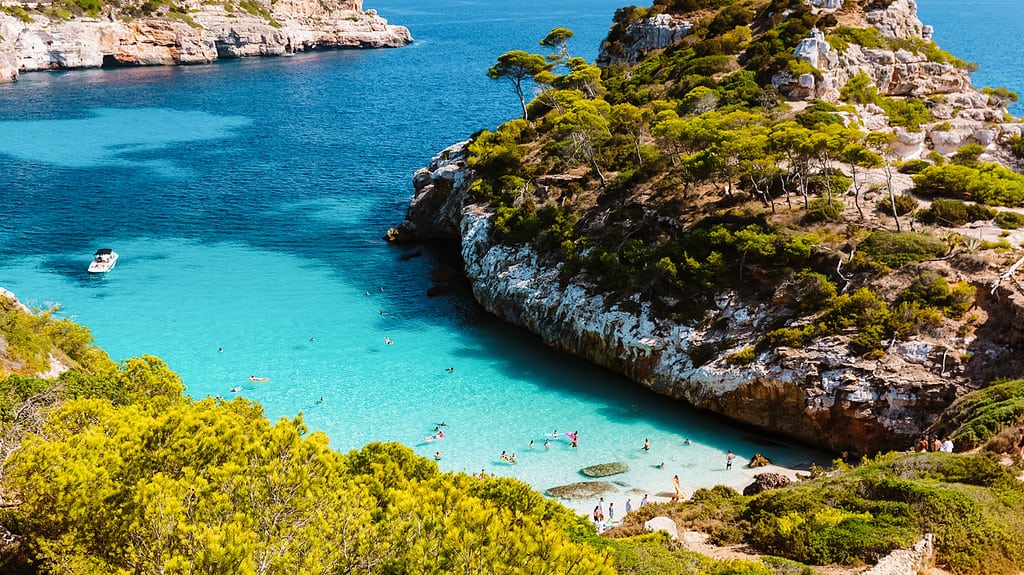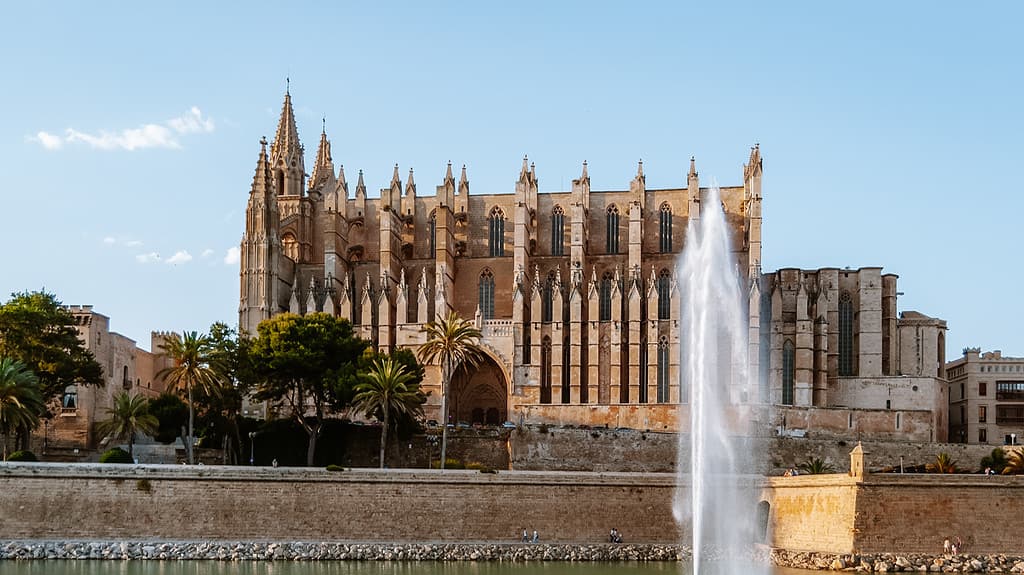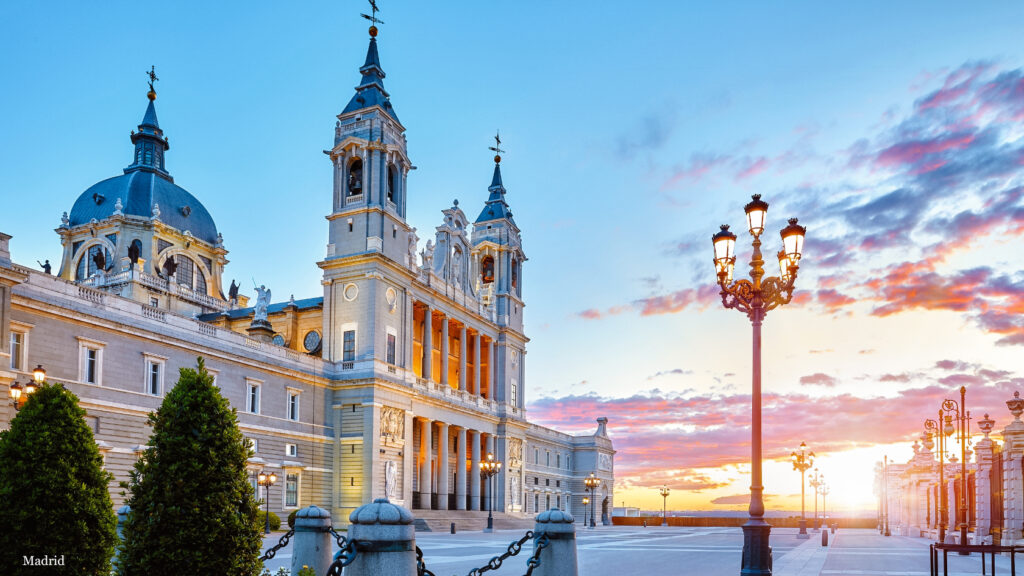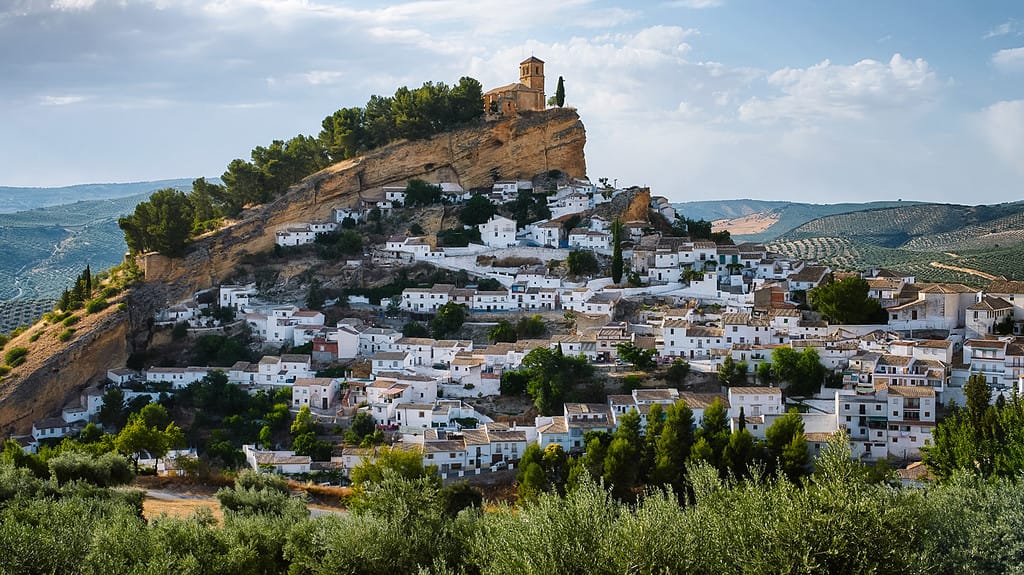Spain – stunning beaches, mountain ranges, vibrant culture and beautiful sights. It’s unbelievable how much this country has to offer. What to see in Spain? What not to miss? Here are 33 tips on the things to do in Spain that you will enjoy.
Whether you’re looking for adventure or just want to relax by the ocean, these places are guaranteed to take your breath away. We’ve also included a map to help you build your itinerary for Spain.
Things to do in Spain: Best places to visit
There are so many great things to do in Spain. From the beautiful golden sand beaches of the Costa Brava or Costa del Sol to the lush mountain ranges scattered across the country. Spain is also home to many beautiful towns and villages. Each is different and each is completely unique and will amaze you with its magnificent architecture.
Let’s take a look at the best places to visit in Spain:
1. Madrid – things to do in Spain
With 3.3 million inhabitants, Madrid is the largest and capital city of Spain and the fifth largest city in Europe.
Other statistics show that Madrid is the second most visited city in Spain after Barcelona. It attracts tourists with its world-famous museums, beautiful architecture and great food.
Madrid is a vibrant and energetic city, where, like Barcelona, it’s alive until the morning.
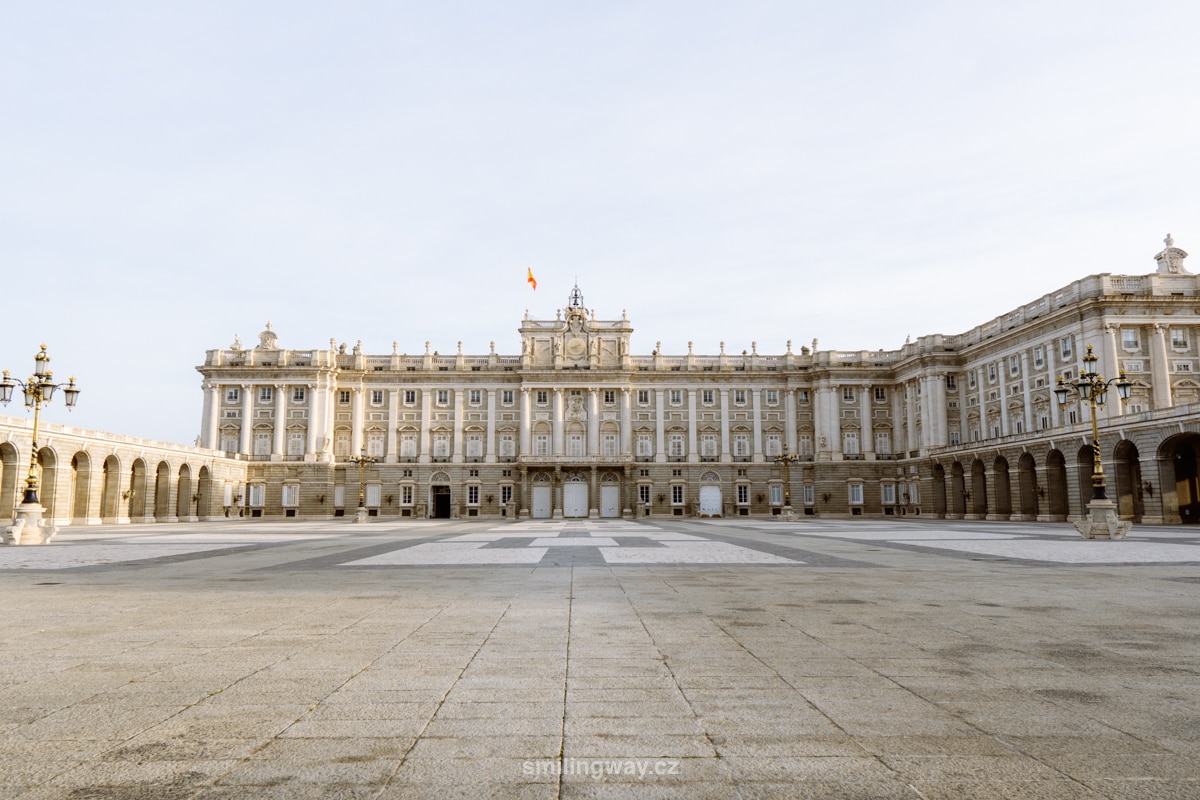
Visit world-famous museums (Prado, Thyssen-Bornemisza, Museo Reina Sofía), explore the Royal Park full of attractions, go for tapas at La Latina, admire the splendour of the Royal Palace or the interior of the Cathedral of Our Lady of Almudena.
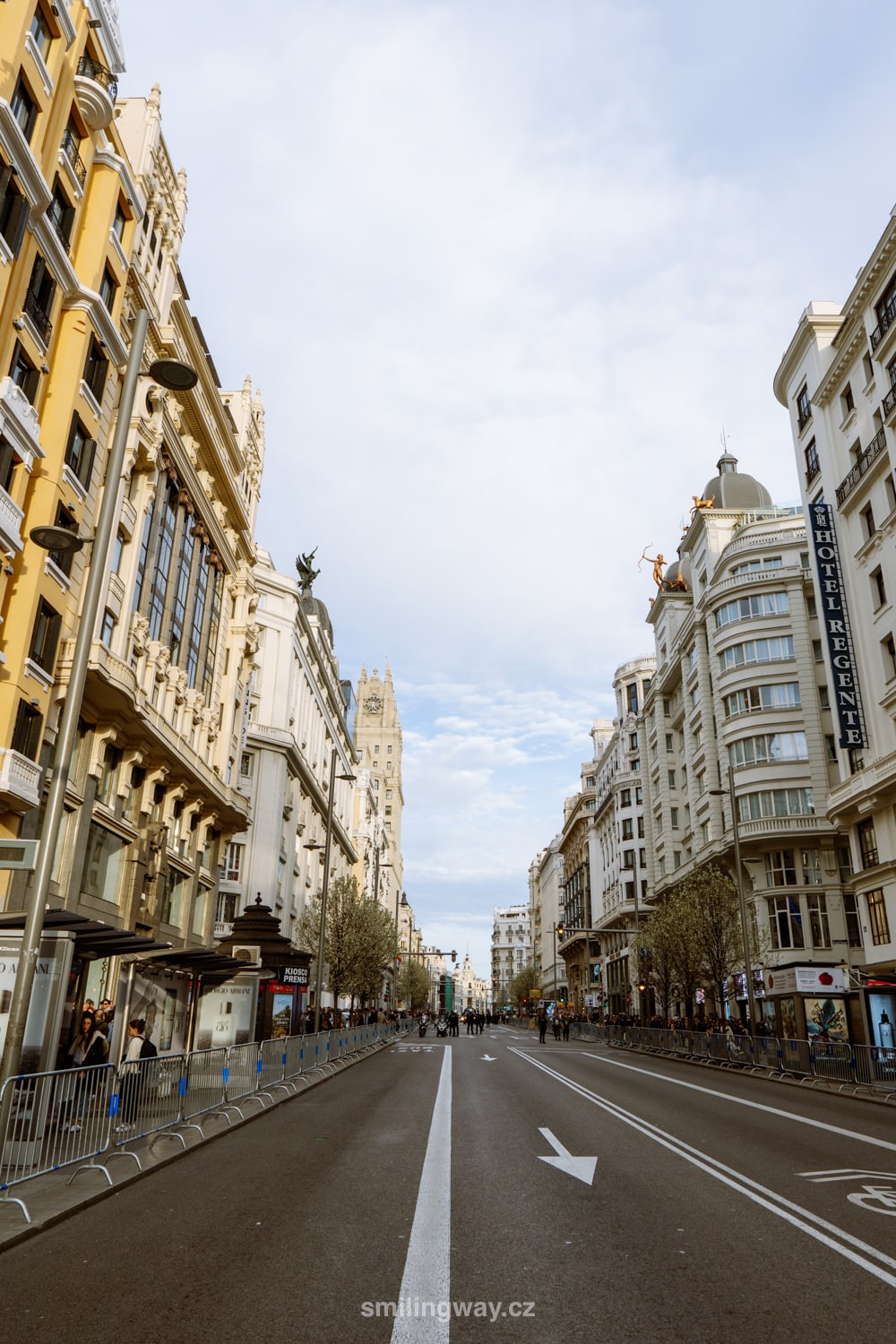
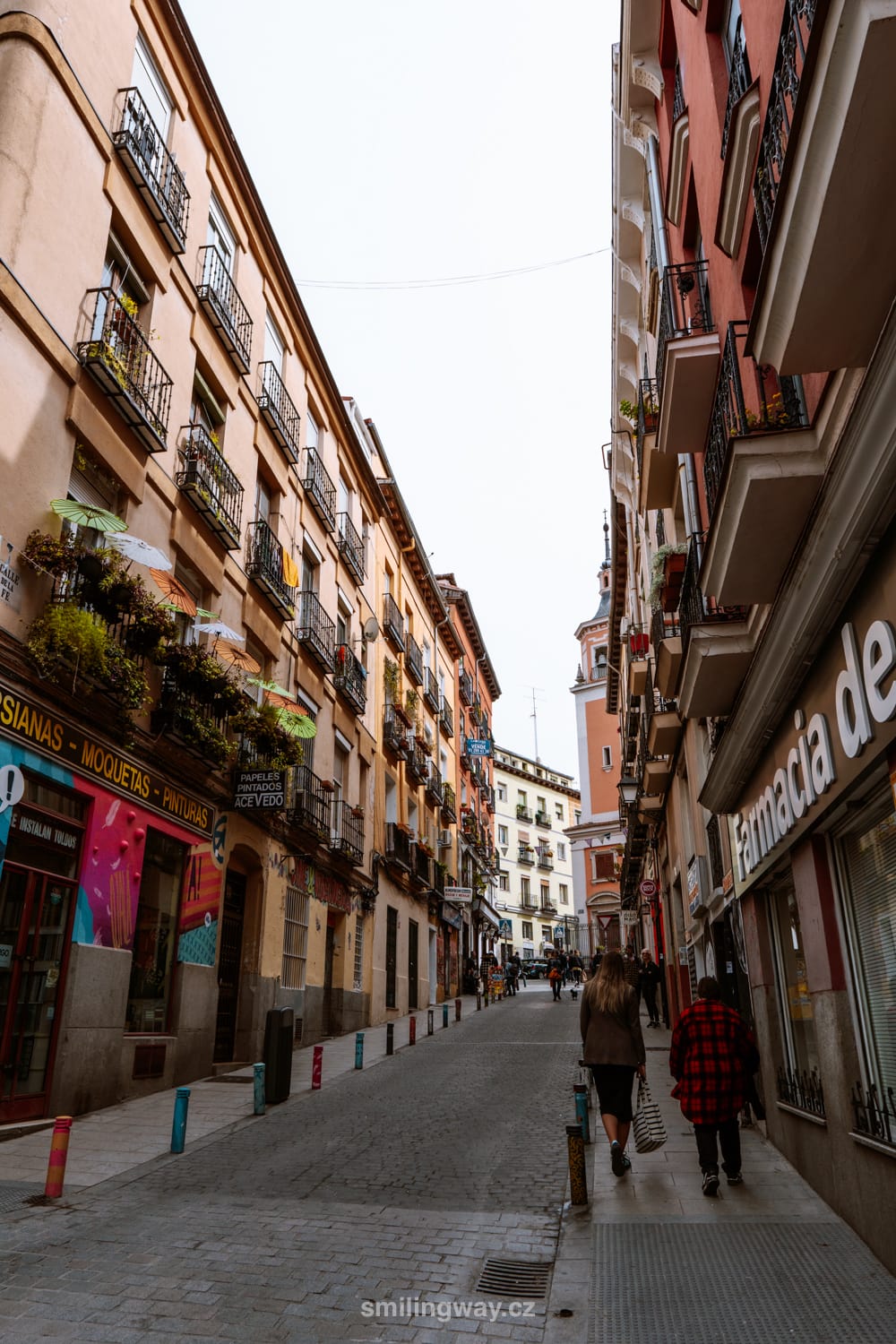
How to get to Madrid
Direct flights from Prague to Madrid operate all year round. Expect a flight time of over 3 hours. Spanish airline offers the most flights Iberia . This is complemented by Czech Airlines and, in high season, the Spanish low-cost airline Vueling .
☞ Read more tips on things to do in Madrid in our previous article or make your own itinerary for 3 days in Madrid.
2. Toledo
Toledo is a beautiful city with a rich historical heritage. Its ancient walls, narrow winding streets and colourful buildings are definitely worth seeing.
Among Toledo’s most beautiful sites is the stunning Toledo Cathedral (Santa Iglesia Catedral Primada de Toledo), which was built in the 15th century. Another top spot is the Alcázar de Toledo, an impressive fortress built by King Charles V. in the 16th century.

Toledo is also home to amazing museums and there are plenty of sights to see in the surrounding area. Cross the Puerta de Alcántara bridge over the Tajo River and enjoy the view of the old town, which is spread out on a hill.
Where to experience the best view of Toledo? The whole city is in the palm of your hand from the Mirador del Valle. In the evening, enjoy the view of the beautifully lit city.
How to get to Toledo: Toledo is easily accessible from Madrid – there’s an hourly express train from Atocha station. The journey takes half an hour.
3. El Escorial Royal Complex
The Real Monasterio de San Lorenzo de El Escorial is an iconic UNESCO-listed monastery complex located near Madrid.
It was built at the end of the 16th century by order of the Spanish King Philip II. and has since become a symbol of Spanish culture and history.
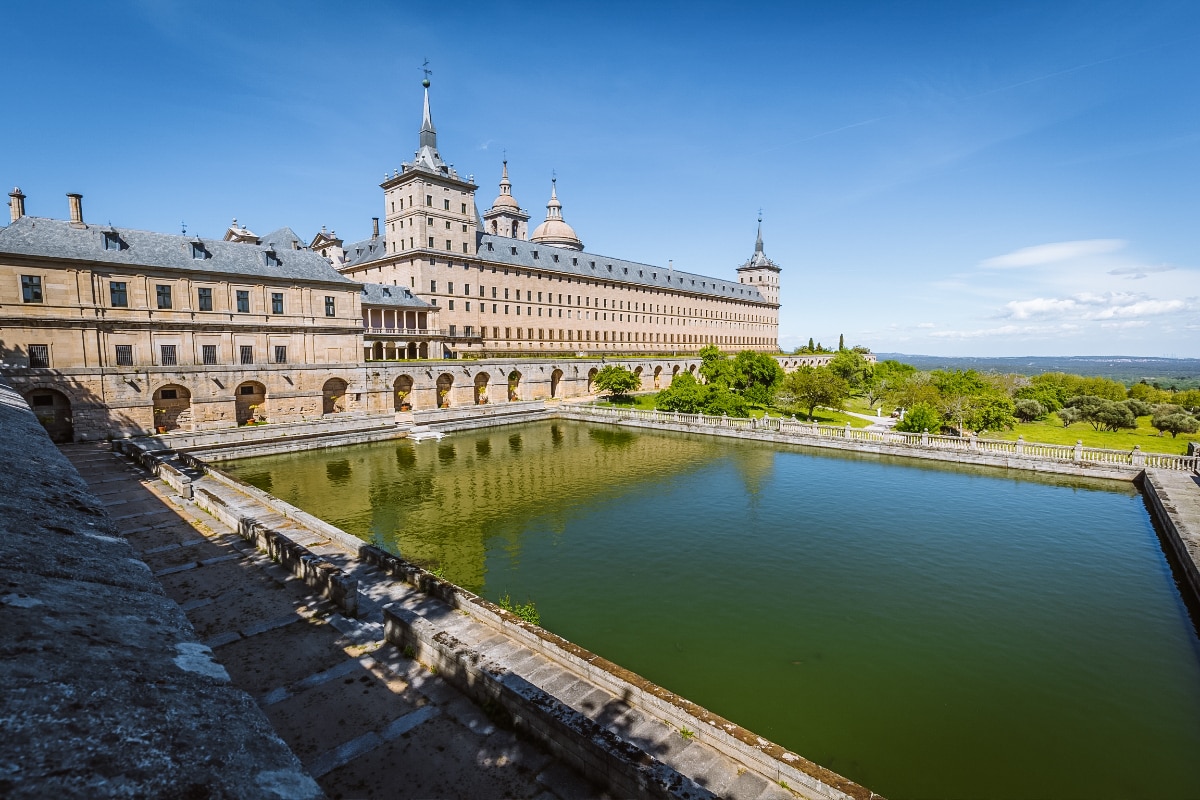
It consists of two parts: the monastery itself and the palace, which was intended as a retreat for King Philip II. and his successors.
During your visit you will see the extensive grounds with courtyards, cloisters, chapels, gardens and other monuments. The most popular sights on the grounds are the Royal Pantheon, where Philip II is buried alongside several other Spanish monarchs; the Basilica of San Lorenzo el Real, a Renaissance church; and the Royal Library, which contains an impressive collection of books and manuscripts.
How to get: The easiest way to reach the Royal Complex of El Escorial is from Madrid, where the regional bus No. 661. You’ll be at your destination in an hour.
4. Barcelona
Since the 1992 Olympic Games, Barcelona has become a beautiful cosmopolitan city that is 2,500 years old. New places and attractions open every year, making Barcelona the ideal city to return to for new experiences.
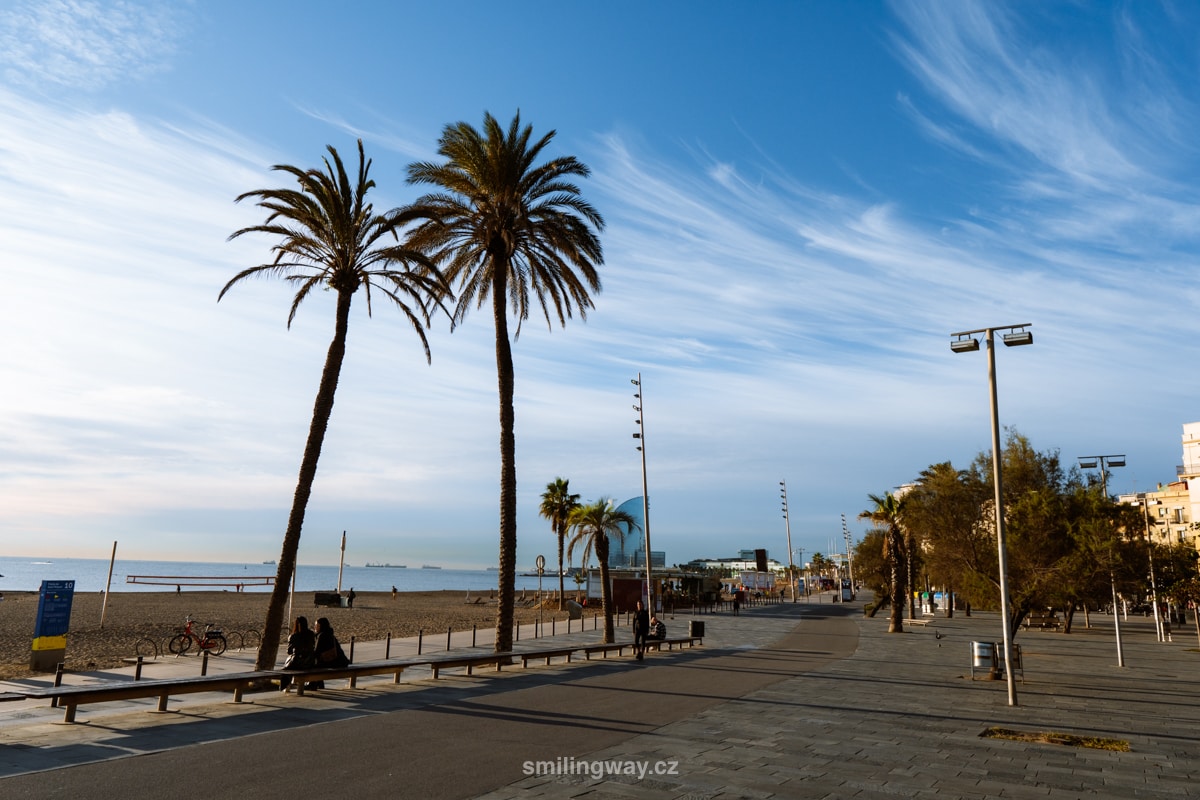
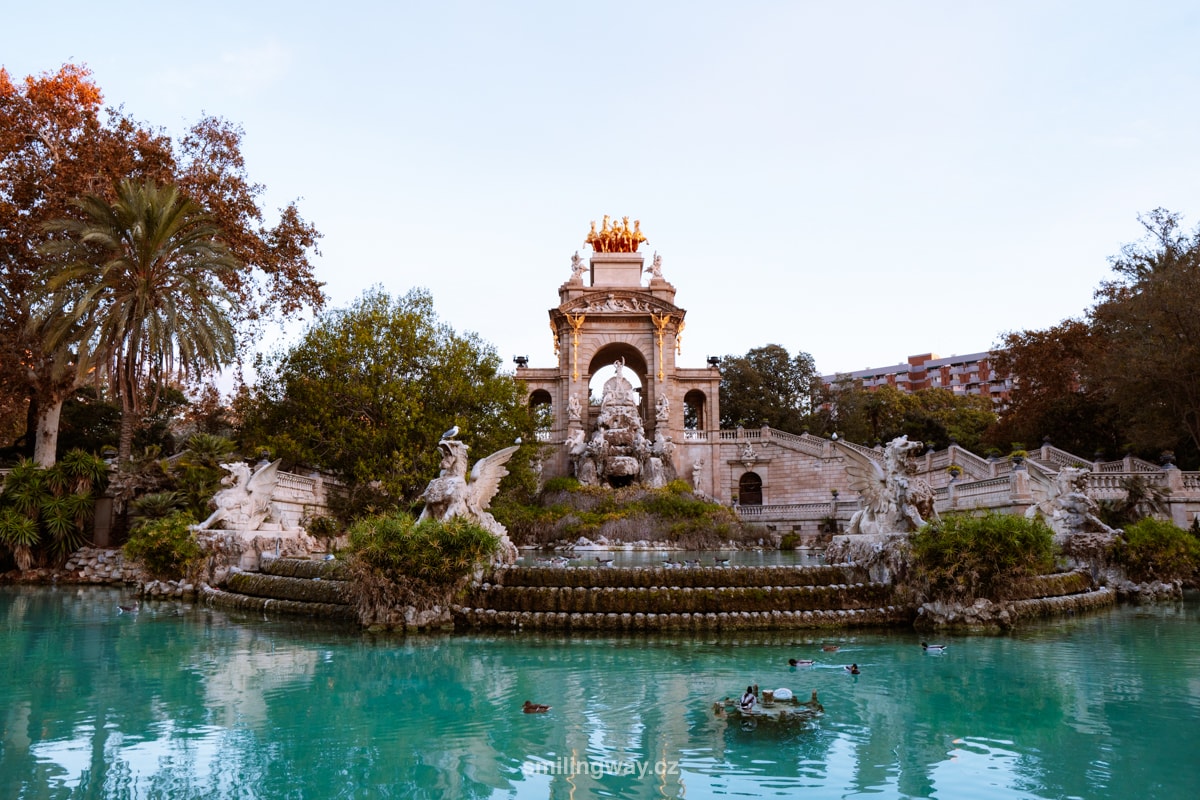
And even though the city struggles with excessive tourism, you’ll fall in love with it. Barcelona’s history oozes from every corner. Whether in the form of the alleyways of the Gothic Quarter or the buildings in which Gaudí’s handwriting from the 19th and 20th centuries (Sagrada Familia, Park Güell, Casa Batlló, etc.).
How to get to Barcelona
Barcelona can be reached by direct flights from Prague in about 2.5 hours. This route is mainly operated by Vueling and Eurowings. Service on both airlines is comparable.
Vueling – The Spanish low fare – low cost airline that flies the most frequently on the Prague-Barcelona route. In season you have a choice of at least two times a day, in winter it flies at least once a day. The price of the basic ticket includes a small luggage with a maximum size of 35x20x20 cm (small backpack).
Eurowings – German low-cost airline that flies less frequently but offers different times for those who don’t like Vueling’s flight times. The price of the basic ticket includes a small baggage with a maximum size of 40 x 30 x 25 cm – the parameters meet, for example CabinZero (28 l) .
☞ Read more tips on things to do in Barcelona or make your own itinerary for 3 days in Barcelona.
5. Girona
Girona is a beautiful city in the north-east of Spain. It is famous for its medieval architecture, which includes the Gothic cathedral of Girona and the Arab baths. One of the most picturesque parts of the city is the Jewish Quarter, or El Call, full of narrow cobbled streets lined with shops and restaurants.
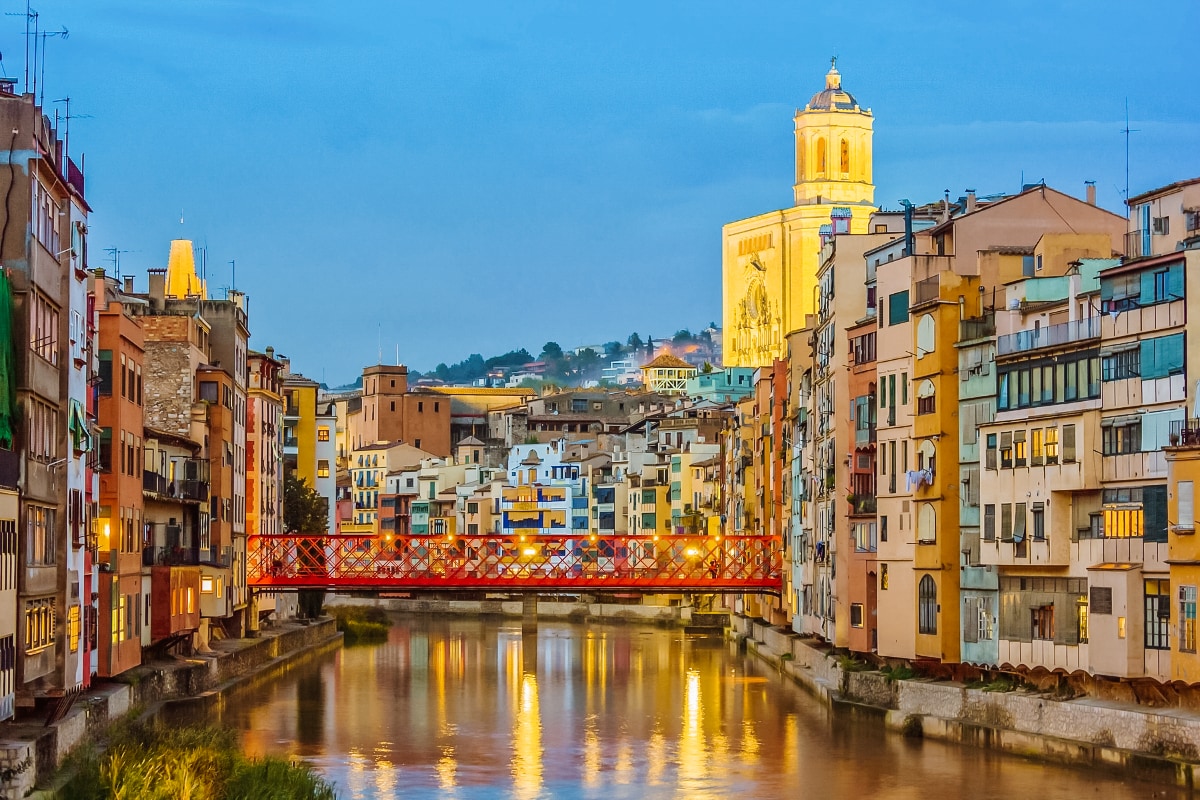
Or visit the Parc de la Devesa, where you can relax in the countryside and enjoy views of the Onyar River. From the red metal Pont de les Peixateries Velles bridge, you’ll experience an iconic view of Girona’s colourful houses.
Getting to Girona: Girona is easily accessible from Barcelona in 40 minutes by express train from Barcelona-Sants Central Station.
6. Montserrat
Montserrat is a mountain in Catalonia and a popular day trip from Barcelona. It is one of the most famous places in the country, famous for its jagged peaks that reach up to 4051 metres.
Montserrat is home to the Benedictine monastery of Santa María de Montserrat, which has been a place of pilgrimage since 1025.
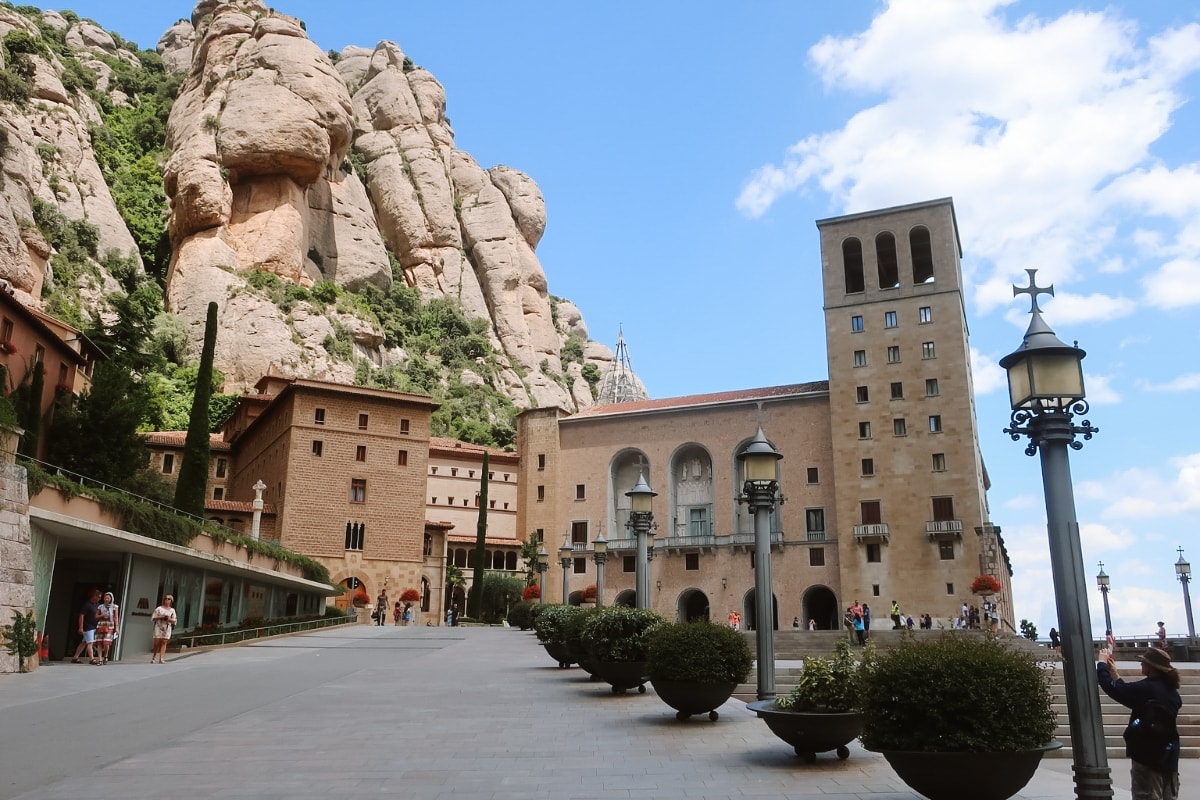
Admire the beautiful countryside, visit the abbey and museum, and enjoy the breathtaking views of Barcelona’s surroundings.
How to get to Montserrat: Montserrat is easily accessible from Barcelona – it takes about an hour to get here by direct train. For a detailed itinerary, see our itinerary for 4 days in Barcelona.
☞ A car is the best way to explore Spain on your own. Because of how popular Spain is, book your car well in advance. This ensures you get the widest choice at the best prices.
7. Valencia
Valencia is a city located in eastern Spain on the Mediterranean Sea. It is one of the most important cities in Spain, where you will find a variety of great attractions, incredible architecture and a rich history.
Some of the most beautiful places to visit in Valencia include La Seu Cathedral, Plaça de la Verge and the beautiful old stock exchange building, Llotja de la Seda.
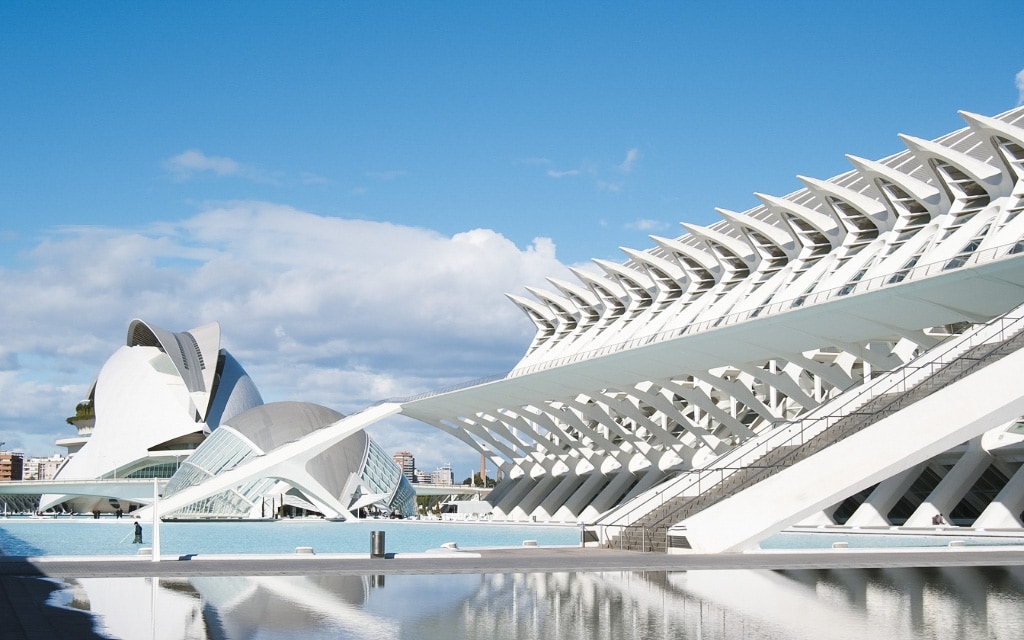
Southeast of the city centre, you’ll see a perfect contrast to the historic buildings in the centre – the largest science park of its kind, with futuristic buildings and lots of greenery, and home to a huge aquarium and science museum.
How to get to Valencia
The direct flight from Prague to Valencia takes 2 hours and 45 minutes. There are 2 airlines operating direct flights between Prague and Valencia:
- Czech Airlines – Traditional Czech airline that also provides hand luggage up to 8 kg in the price of the ticket.
- Eurowings – German low-cost airline that includes a small luggage bag with a maximum size of 40 x 30 x 25 cm in the price of the basic ticket – parameters that meet, for example CabinZero (28 l).
Direct flights are not on offer for the whole year. If the date doesn’t suit you, here you can search for flights with a transfer .
Another option is to fly to Madrid or Barcelona, which have good train connections to Valencia.
☞ Here is a travel guide and best things to do in Valencia.
8. Canary Islands – the most beautiful islands in Spain
The Canary Islands, the enchanting Spanish archipelago off the coast of northwest Africa, boast a variety of destinations, from the beautiful beaches of Tenerife and Gran Canaria to the moonlit terrain of the volcanic fields of Lanzarote. Thanks to this, there is something for everyone, whether you are looking for relaxation by the sea or adventurous excursions in rough terrain.
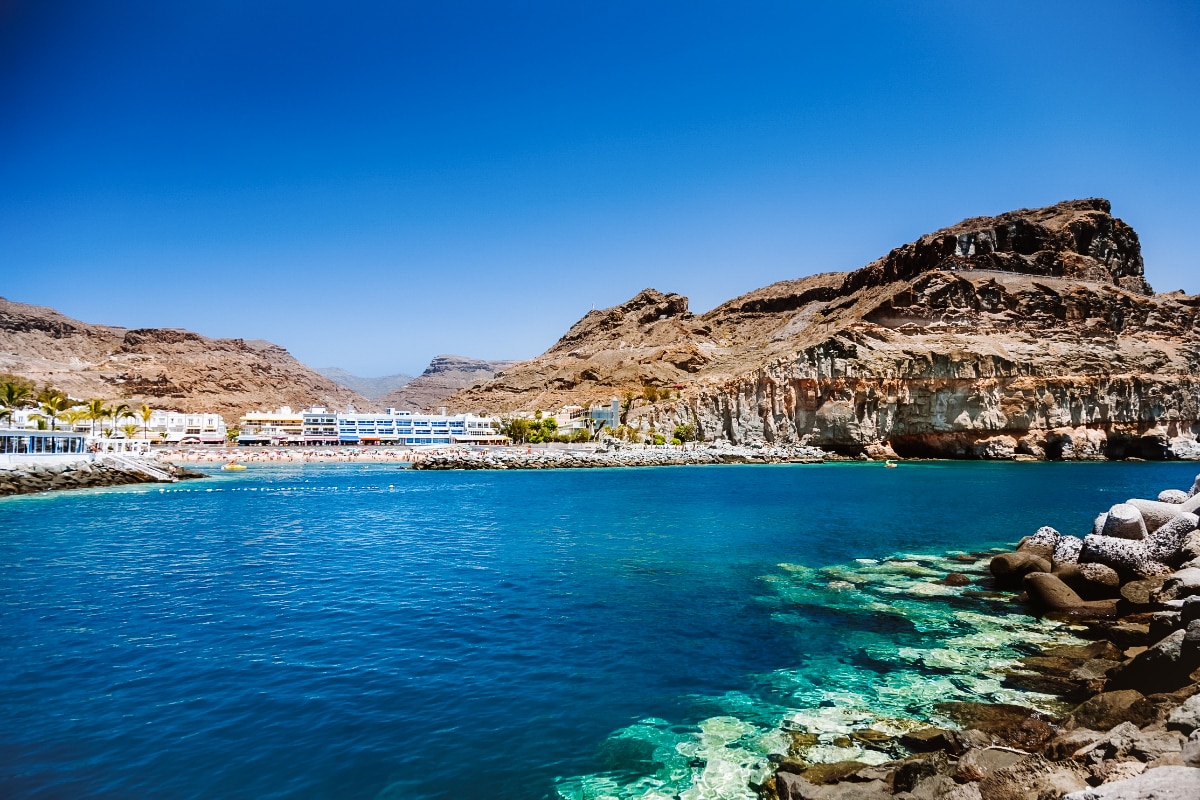
Enjoy delicious cuisine based on a combination of traditional Spanish recipes with African and Latin American influences. Head to one of four national parks and a number of protected areas. In Tenerife’s Teide National Park, a UNESCO World Heritage Site, is Mount Teide, Spain’s highest peak and a great example of volcanic landscape.
The mild temperatures and abundant sunshine make the Canary Islands an ideal destination all year round.
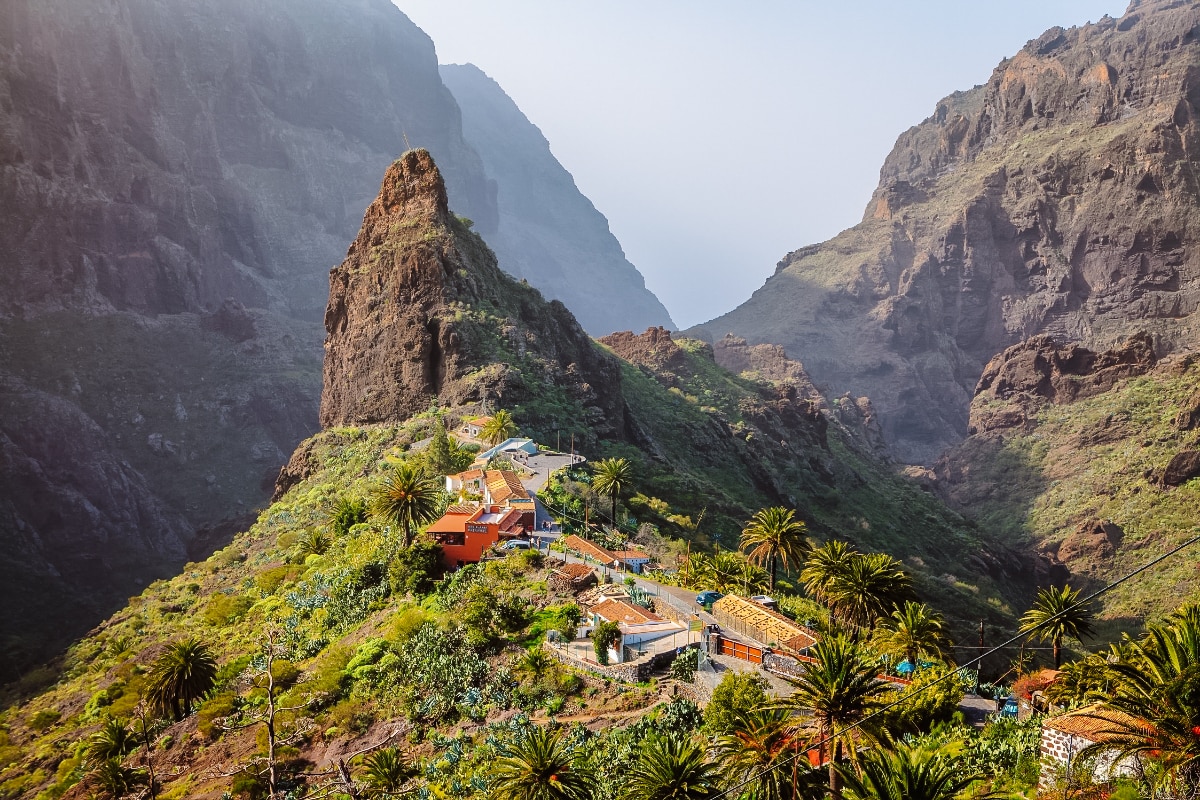
How to get to the Canary Islands
From Prague you can reach the Canary Islands with direct flights all year round. Smartwings flights to Fuerteventura, Czech Airlines to Tenerife and Las Palmas de Gran Canaria. The price of the basic ticket includes a hand luggage of 8 kg.
The final flight time varies depending on which island you’re flying to, but in all cases expect around 5 hours.
9. Alicante – things to do in Spain
Alicante, a lively port city on Spain’s south-eastern Costa Blanca, offers a great mix of history, culture and Mediterranean beauty.
Alicante is famous for its beautiful beaches, such as Postiguet Beach, which is right in the centre of the city and offers golden sand and clear waters. Wander through the old town with its narrow streets and colourful houses, or climb up to Santa Bárbara Castle for the best views of the city.
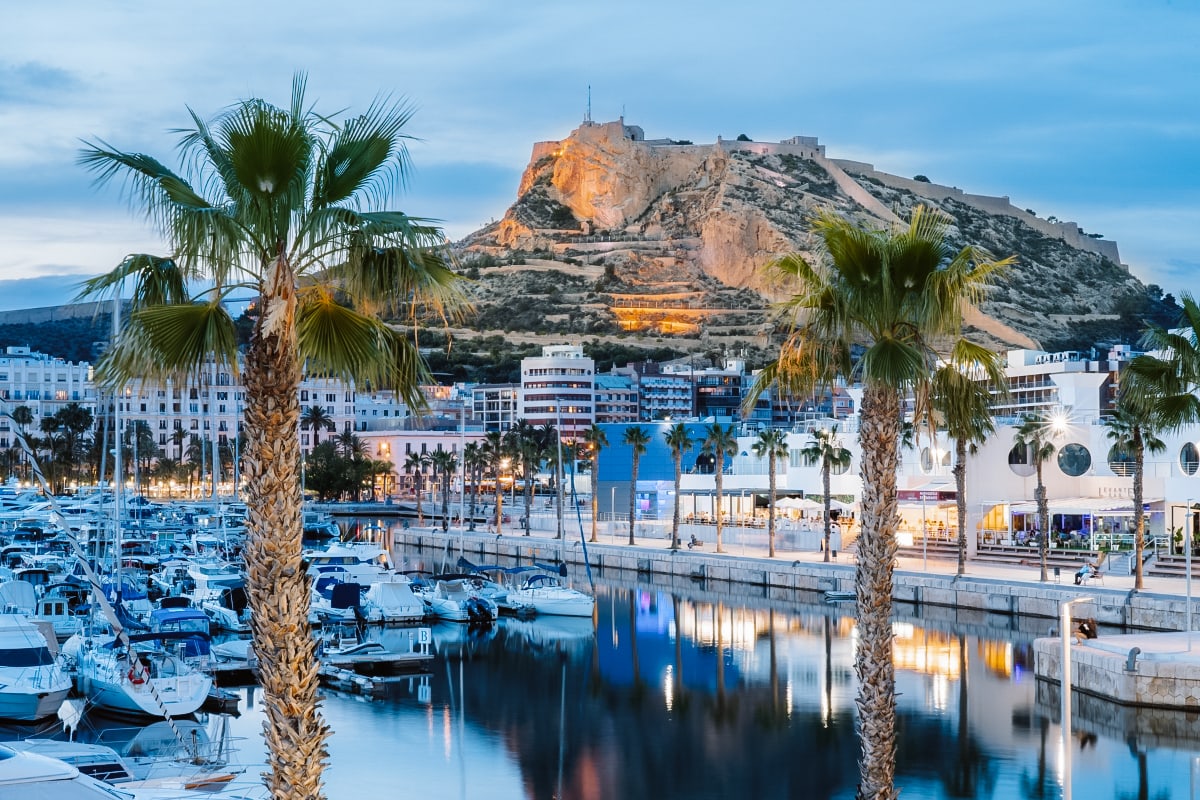
The town is also a great base for exploring the Costa Blanca, known for its picturesque villages, hidden coves and bustling resorts.
How to get to Alicante
Direct flights Prague – Alicante are available in high season from April to October. German airline to choose from Eurowings and British airline EasyJet . In both cases, these are low-cost airlines with almost no difference in price, and you only get a small backpack/bag in the price of the basic ticket.
10. Costa del Sol
The Costa del Sol in Andalusia, translated as “Sunny Coast”, is located on the southern coast of mainland Spain in the province of Malaga. The area has some of the most stunning beaches in Spain and more than 300 days of sunshine a year. Thanks to this, the Costa del Sol has become one of Spain’s most popular holiday destinations.
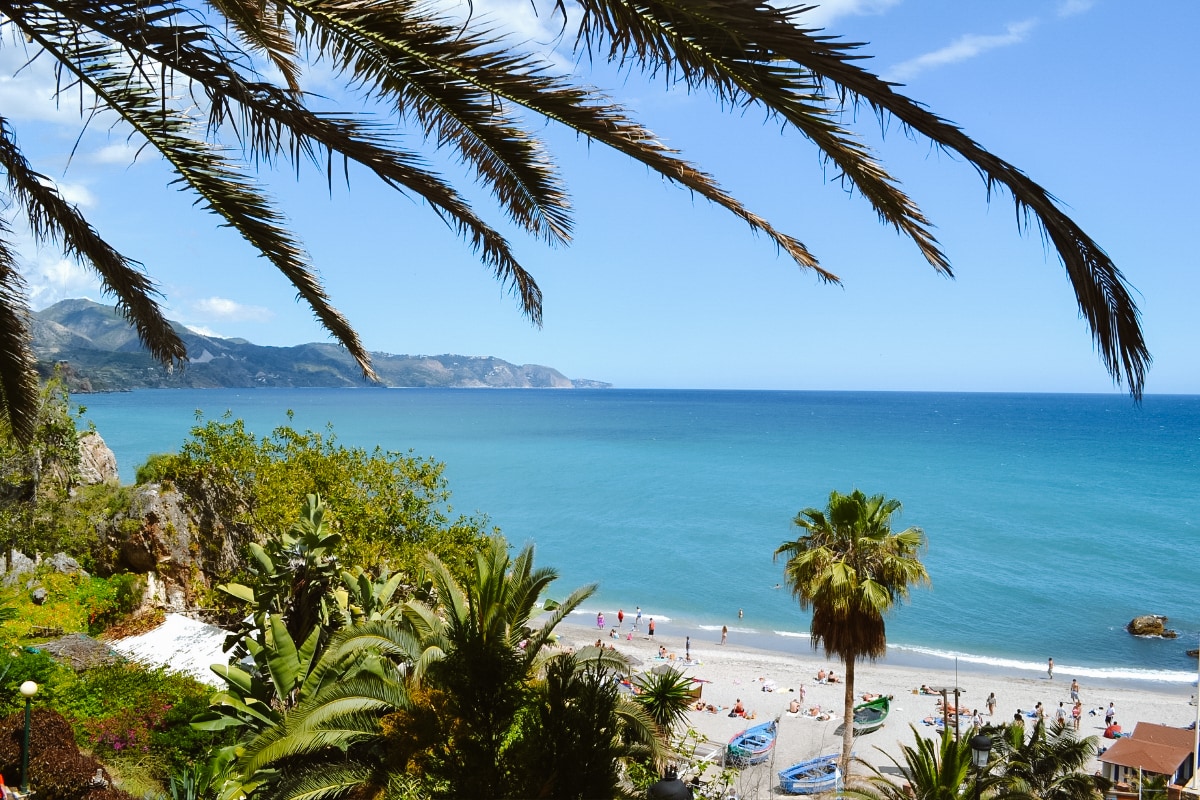
From white sandy beaches to picturesque fishing villages and seaside resorts to fantastic mountain views from Moorish castles, there is something for everyone.
The Costa del Sol is also home to a vibrant nightlife and great cuisine, with a wide range of restaurants serving traditional Andalusian and international dishes.
How to get to the Costa del Sol
The Costa del Sol can be reached from Málaga Airport – a direct flight from Prague takes 3 hours and 20 minutes. Airlines to choose from Czech Airlines which flies all year round and Eurowings which flies mainly in high season.
11. Peniscola
Peniscola is a historic coastal town in the province of Castellon. It is located about 50 km from Valencia.
The dominant feature of the town is the imposing castle built by Pope Benedict XIII. in 1394 and the old city walls, which still stand today.
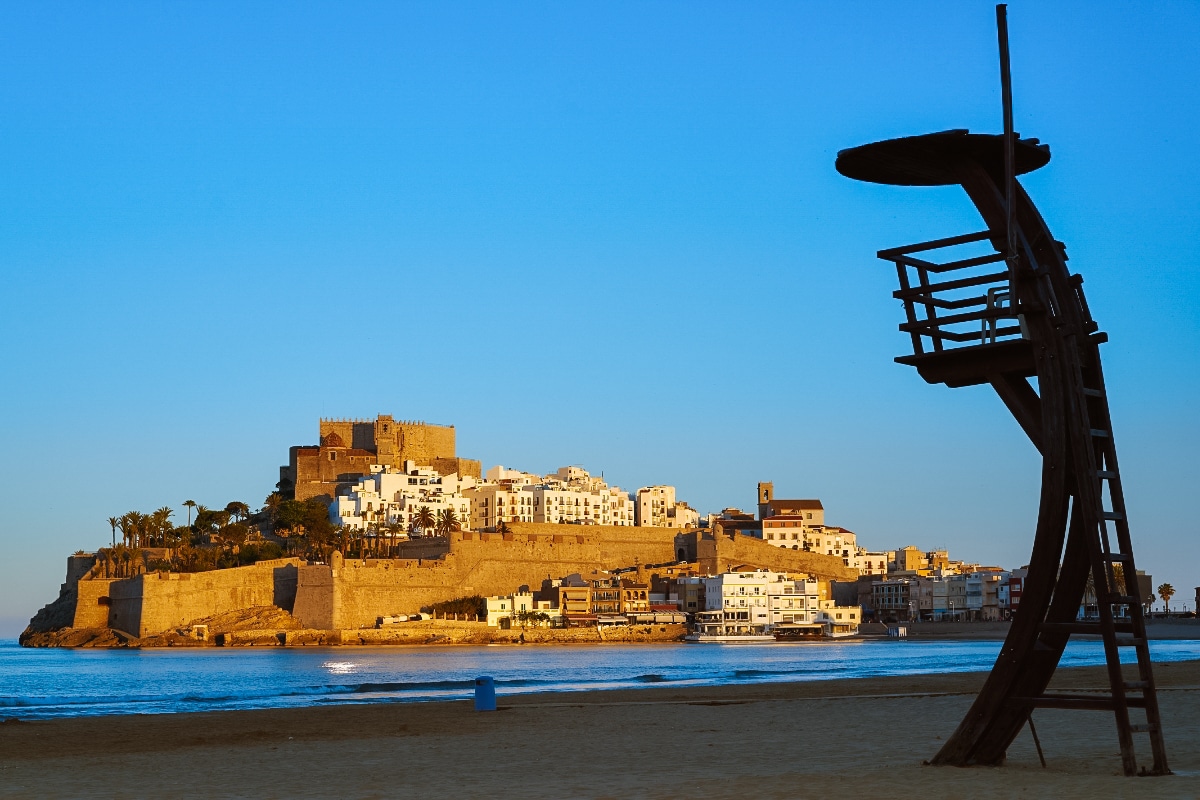
The old quarter of Peniscola comprises narrow cobbled streets lined with characteristic white houses, giving a unique atmosphere of a traditional fishing village.
How to get in: Peniscola is about 1.5 hours northeast of Valencia. It is most easily accessible by car.
12. Albarracín
Albarracín is a beautiful town located in the province of Teruel in the Spanish Aragon. Albarracín sits on top of a hill and is surrounded by steep mountains that make it look like something out of a fairy tale.
It is famous for its breathtaking views and incredible architecture. It is this combination that for several years brought it to the top of the list of the most beautiful villages in Spain.
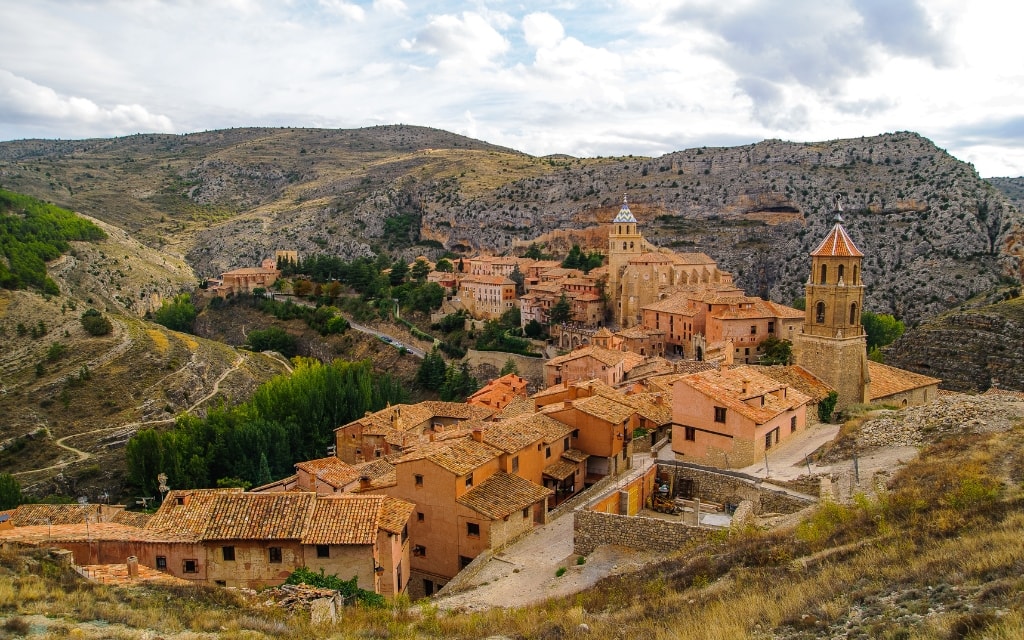
Walk the whole old town, from one side to the other. It will only take you a few hours. From here, you can climb up to the fortress, which you will see high above the city on your arrival. It is here that the most iconic photographs of the old town set in the surrounding rocky mountains are taken.
How to get in: Albarracín is halfway between Valencia and Madrid. Due to its remote location in the mountains, it is most easily accessible by car.
13. Teruel Desert
In the Teruel Desert, you get the feeling that you have moved to the Grand Canyon region of the United States. It is located in the Aragon region between the village of Albarracín and the beautiful town of Teruel.
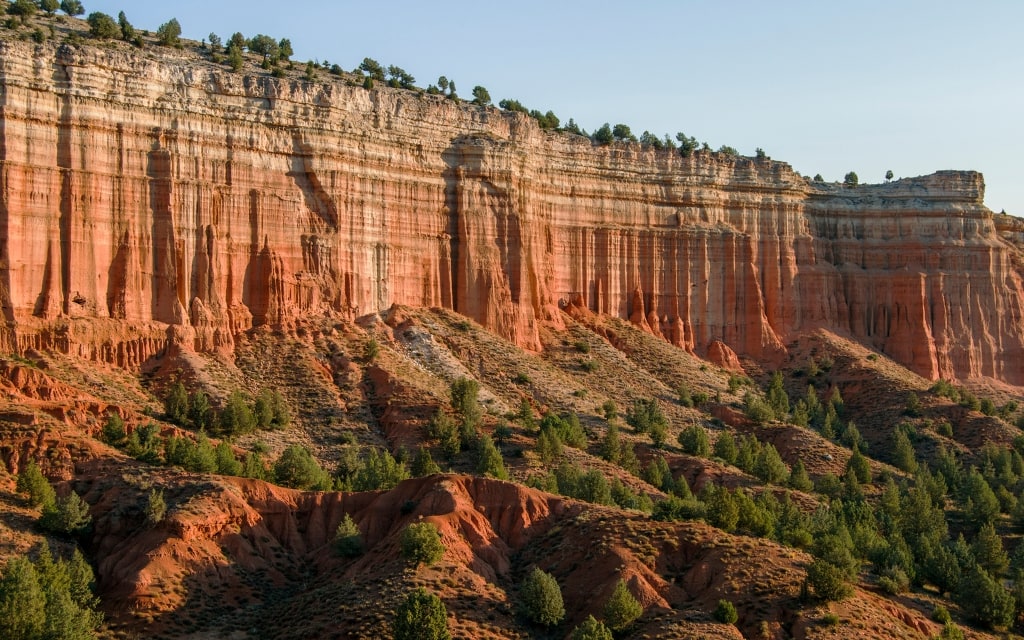
The Teruel Desert is a unique landscape of eroded mountains and canyons. It was formed by an ancient sea that dried up here millions of years ago, leaving behind spectacular rock formations along with fossils and other evidence of its passage.
There are many archaeological sites here, including cave paintings from the Paleolithic period, which have been well preserved in the dry climate.
How to get in: The Teruel Desert is only half an hour’s drive from the town of Albarracín, so you can combine both places into one trip.
14. Segovia
Segovia is a charming ancient town in the Spanish region of Castilla y León, just an hour northwest of Madrid. Segovia is famous for its old city walls, impressive Roman aqueduct and the Alcázar de Segovia Castle, making it one of the most beautiful places to visit in Spain.
How to get in: Segovia is just an hour by fast train from Madrid.
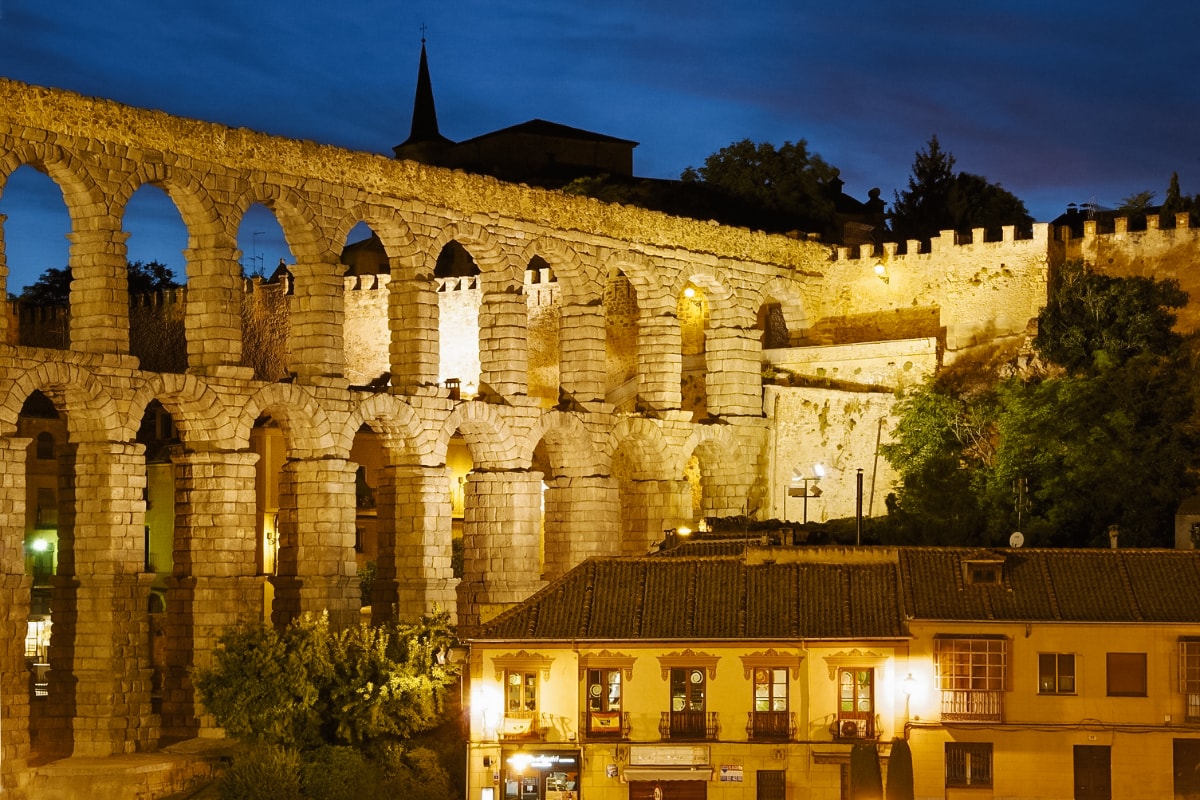
15. Bilbao
Bilbao is located in northern Spain along the Nervión River. It’s a beautiful city known for its vibrant culture, art museums and the stunning Frank Gehry-designed Guggenheim Museum.
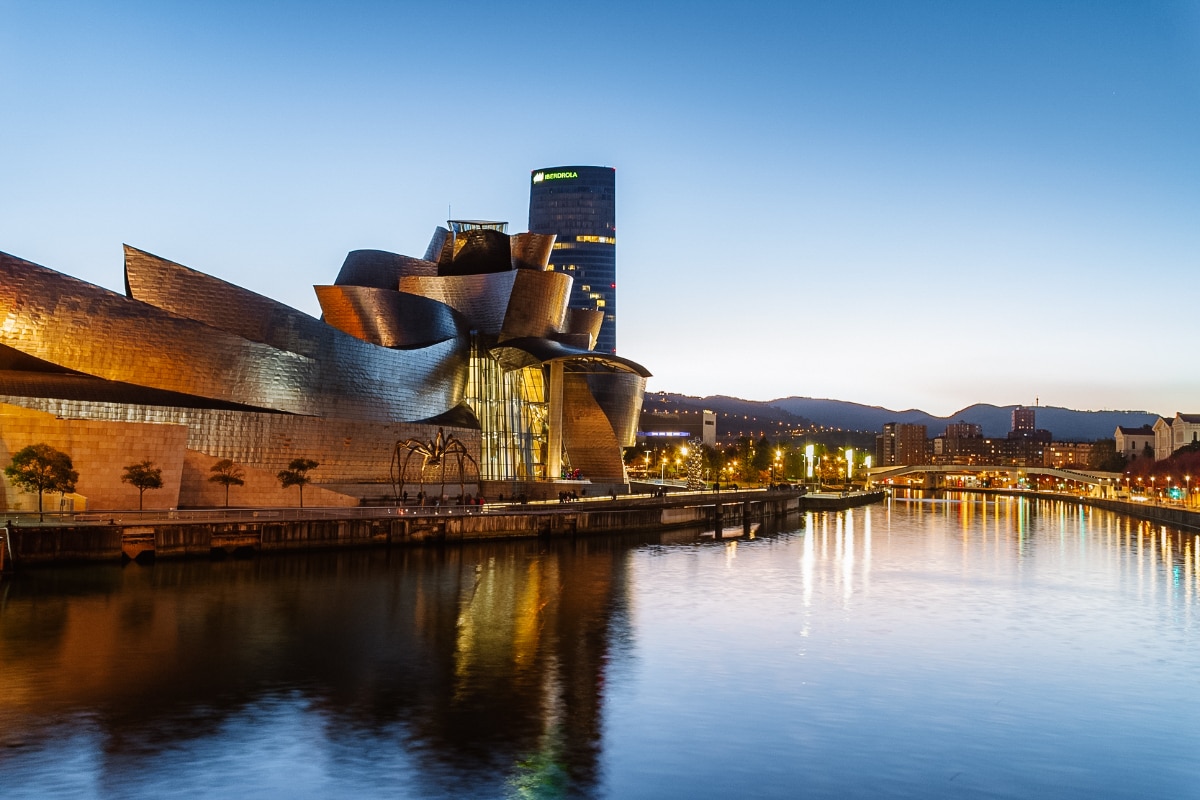
Explore the old town centre of Casco Viejo, with its narrow cobbled streets lined with traditional Basque architecture. There are also several beautiful beaches with views and a harbour around the town.
How to get in: Bilbao is located in the north of Spain near the French border. If you’re not driving your own car and are looking for a direct flight, check out
Vueling
. It offers several flights a week in the season from July to the end of October. For the rest of the year, only connecting flights are possible.
16. Burgos
In the north of Spain, near Bilbao, lies Burgos. A city full of culture, history and art, with its entire historic centre a UNESCO World Heritage Site.
And while there are many attractions, monasteries, churches and palaces, the most beautiful monument is the Cathedral of Santa Maria de Burgos, which dates back to 1221 and is a perfect example of Gothic architecture. Take a stroll through its surrounding streets, which are lined with pastel-coloured houses.
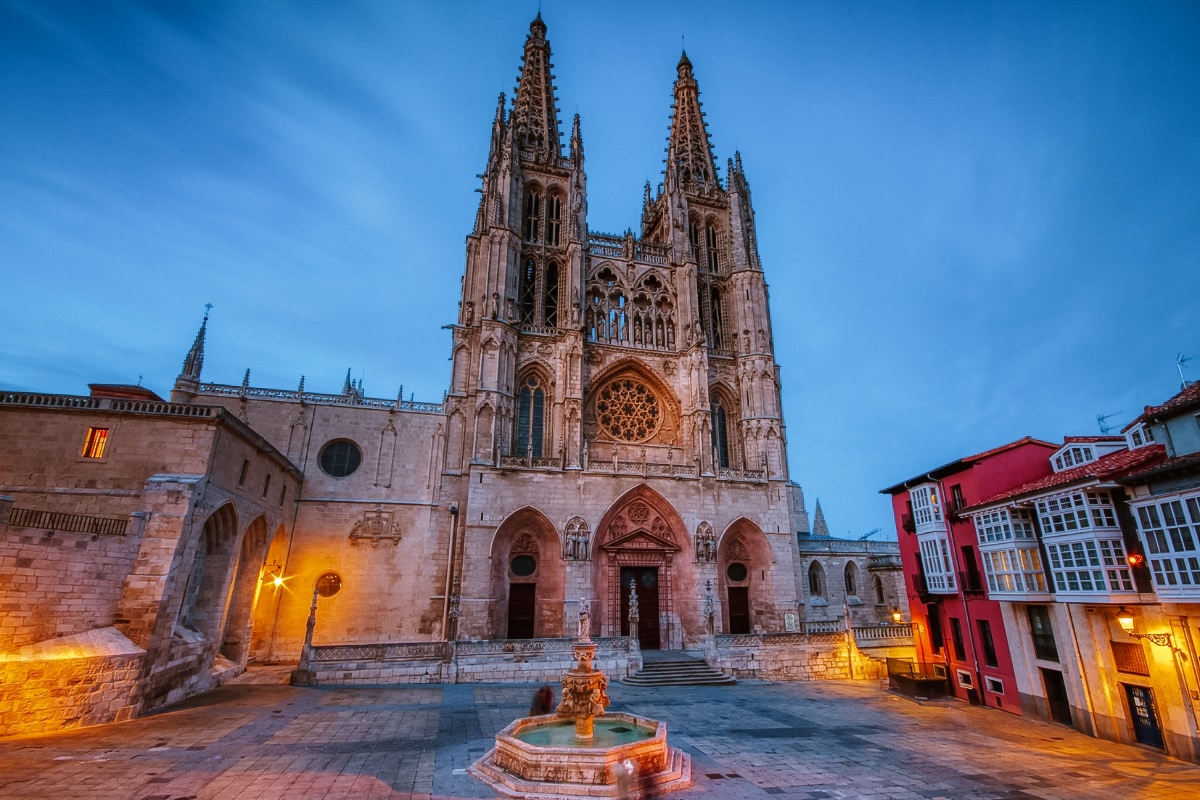
And where to enjoy the best views of Burgos? From the cathedral, follow the signs towards the castle, which will take you to the Mirador Del Castillo viewpoint. Or climb up to the castle, where the views are also worth it.
How to get: Burgos is located north of Madrid. It takes 1.5-2 hours to get here by direct train.
17. Asturian coast
Asturias is one of the best areas in Spain to visit thanks to its beautiful countryside, vibrant culture and wealth of activities.
The Asturian coastline stretches along the Bay of Biscay. It is known for its beautiful beaches and rugged coastline, as well as great surfing spots. The nearby mountains provide a panorama with fantastic views. According to Greenpeace, this is one of the most preserved coastlines in Spain.
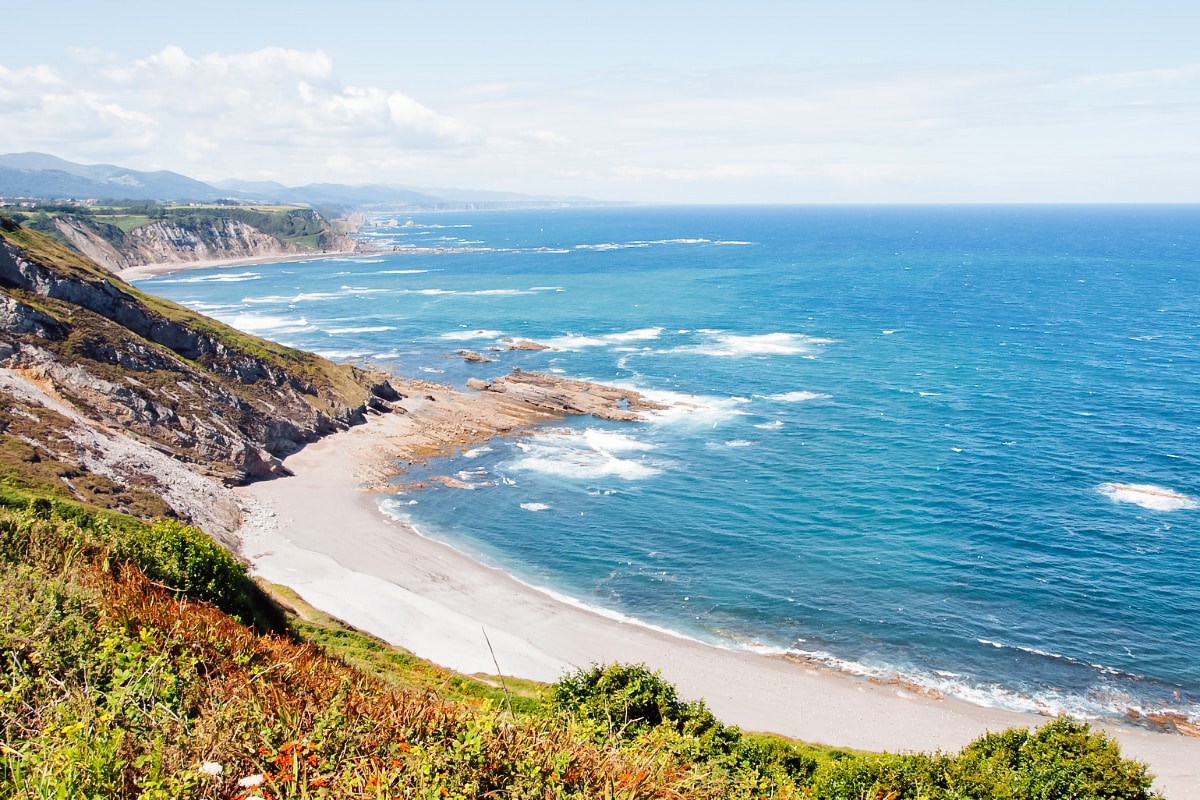
The coast is lined with eighteen fishing villages and over two hundred beaches where you can swim, fish, sail or go windsurfing or kitesurfing. And when you get tired of the water fun, go hiking in the surrounding hills or discover the traditional architecture in the surrounding villages.
How to get: Asturias is located in the north of Spain. The entire area is served by a smaller regional airport, served by local airlines. A car is the best way to explore the entire coast of Asturias.
18. Los Picos de Europa National Park
Los Picos de Europa National Park is located in the northern part of Spain and is spread over three autonomous regions – Asturias, Cantabria and Castile and Leon. It is a spectacular landscape with steep peaks and deep valleys, full of lush greenery and wildlife.
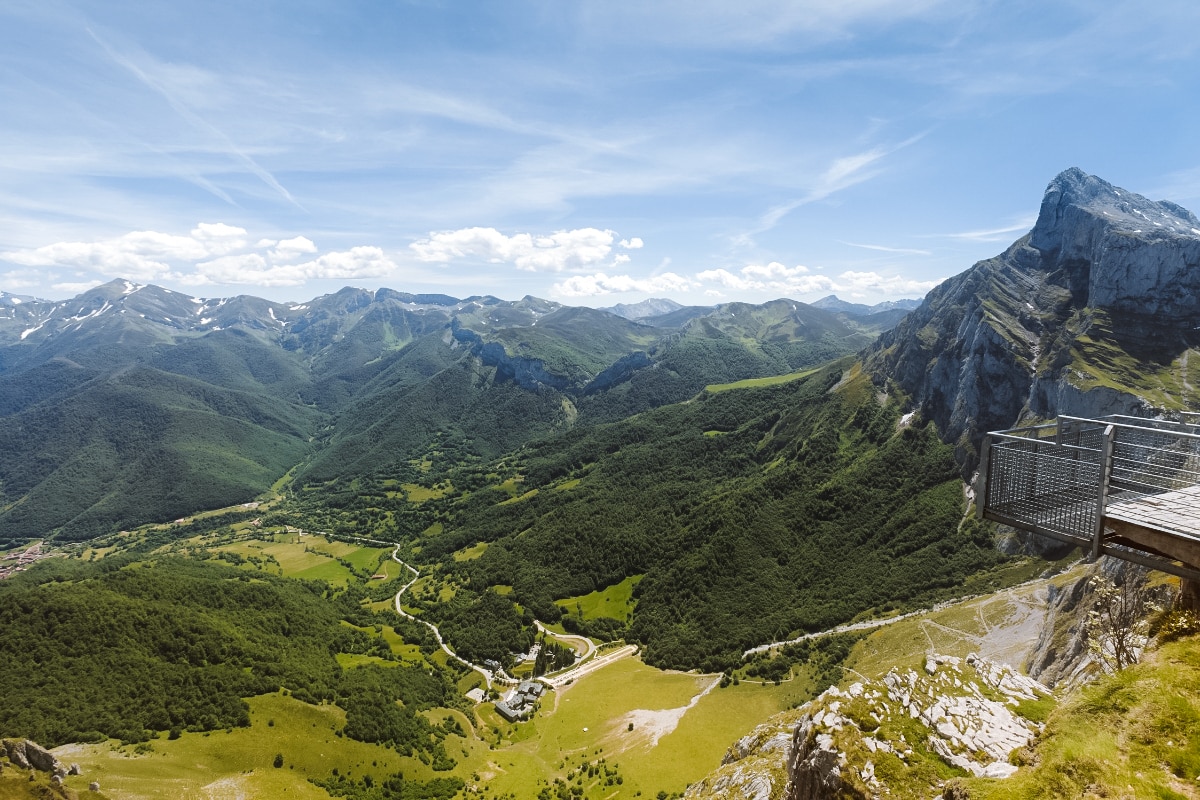
One of the best reasons to visit Los Picos de Europa National Park is its incredible scenery. You won’t find a sight like that anywhere else. Whether you just enjoy the views from your car window or hike along one of the hiking trails of varying difficulty.
How to get: Los Picos de Europa National Park is located in the north of Spain. A car is the best way to explore the park.
☞ Car is the best way to explore Spain on your own. Given how popular Spain is, book your car well in advance. This ensures you get the widest choice at the best prices.
19. Salamanca
Salamanca is located in the western part of Spain, approximately 90 km west of Madrid.
One of Salamanca’s main attractions is its beautiful old town, a UNESCO World Heritage Site since 1988. The old town has a number of beautifully preserved churches dating back hundreds of years and picturesque cobbled streets lined with traditional shops and restaurants.
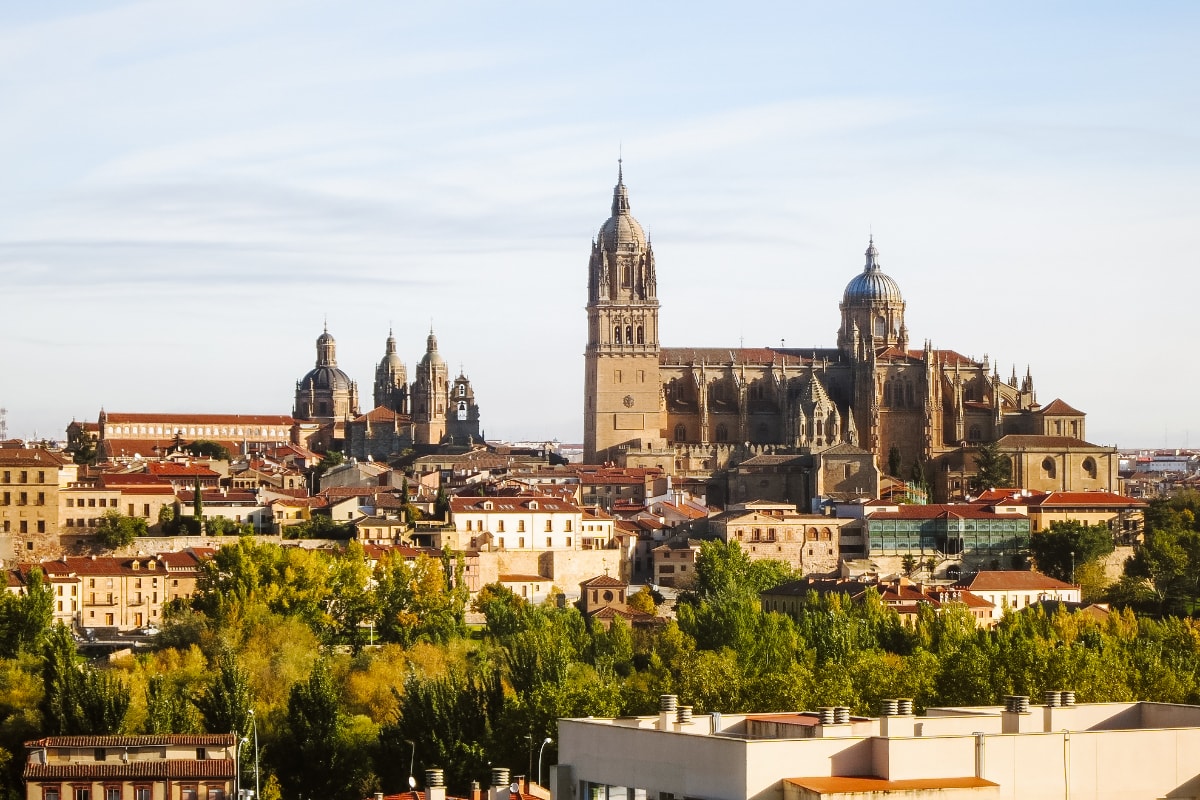
Don’t miss the Plaza Mayor – an iconic square from the 18th century, surrounded by Renaissance-style buildings, and a Gothic-Baroque cathedral that towers high above the city skyline.
How to get: Salamanca is located east of Madrid, from which it can be reached in 2.5-3 hours by direct train.
20. Seville – the best places in Spain
Seville is the capital of Andalusia in southern Spain. It is a beautiful city full of history and culture – once home to Christopher Columbus and Ferdinand Magellan. Among Seville’s most beautiful sights are La Giralda Cathedral (the largest Gothic cathedral in the world) and the Reales Alcazares (an old 10th-century Moorish palace).
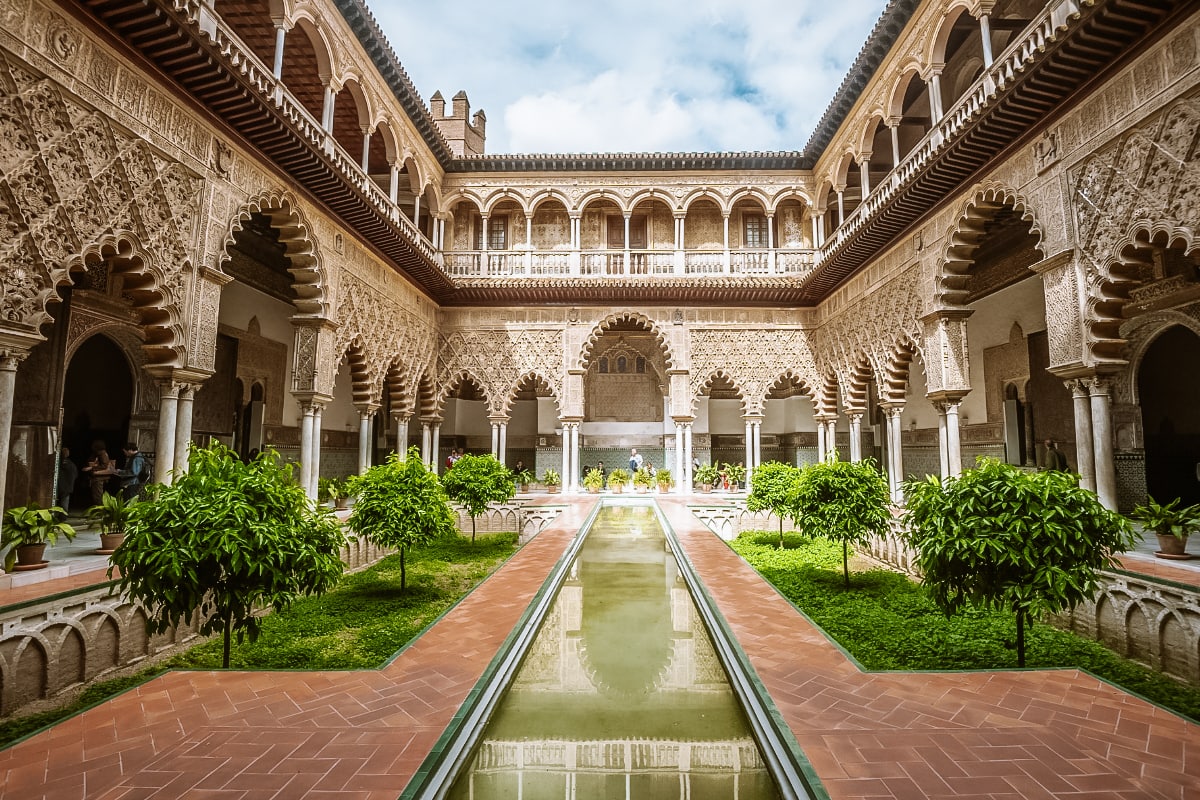
Don’t miss the Setas de Sevilla, an ultra-modern mushroom-shaped structure that forms a perfect contrast to the historic buildings in the area.
But Seville has much more to offer, including excellent cuisine. On warm days you can visit one of the parks and gardens, the most popular being the Maria Luisa Park, full of beautiful buildings, fountains and waterfalls.
How to get to Seville
Seville is easily accessible by direct train from Málaga (2 hours), with Czech Airlines and Eurowings flying in all year round (see Costa del Sol for more information).
☞ Read our travel guide and best things to do in Sevilla.
21. Granada
Another Spanish city you must visit is Granada. The Alhambra Palace is one of the most beautiful UNESCO-listed monuments in the world and will literally enchant you as you walk around the fortress, palaces and courtyards (wear comfortable shoes, you’ll walk a lot).
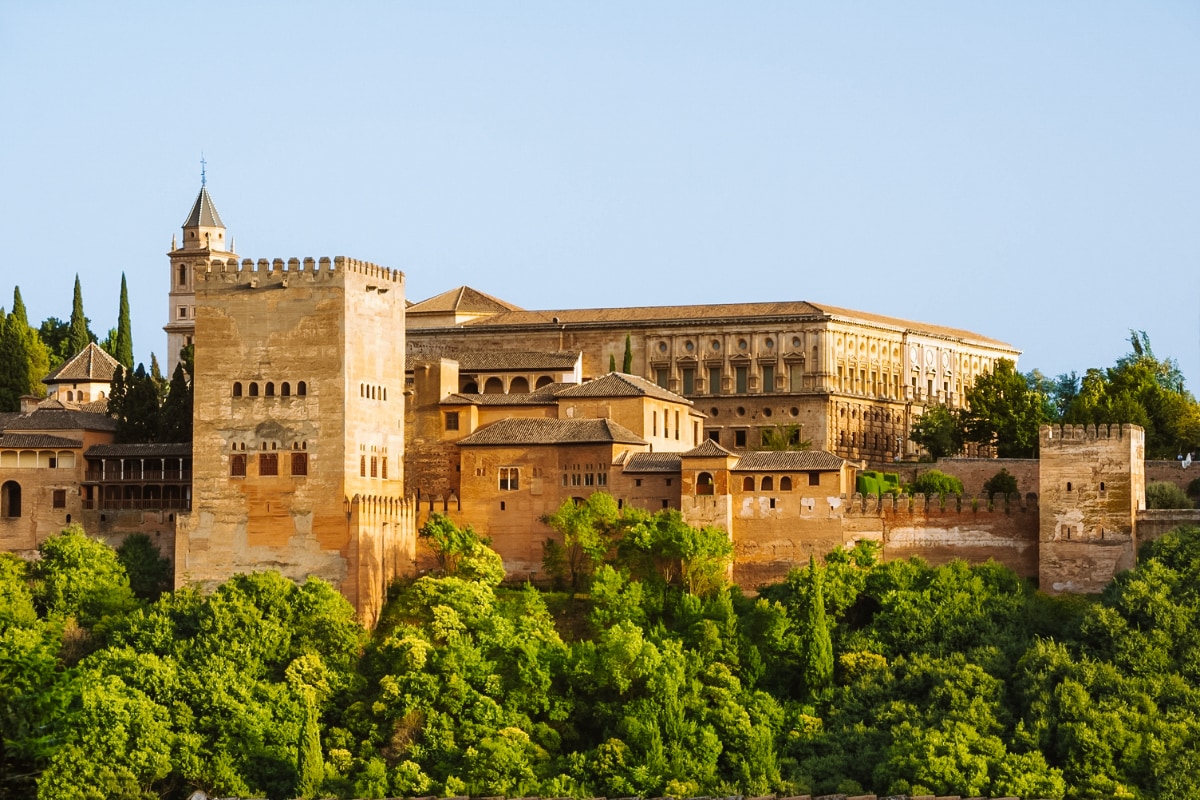
We were enchanted by the Albaicín district, where you can wander through a labyrinth of narrow stone streets lined with white houses festooned with colourful flowers. You can walk up to the Mirador de San Nicolás lookout point, which offers a perfect view of the Alhambra Fortress and the wooded hills.
How to get to Granada
Granada is only 1.5 hours by car from Málaga, which can be reached by direct flight from Prague (Czech Airlines and Eurowings).
In Málaga you can take the Alsa or Avanza buses, which take you from Málaga Bus Station to Granada in less than 2 hours.
If you prefer an organised trip, this trip from Málaga to Granada includes transport and admission to the Alhambra Palace.
☞ Read our travel guide and things to do in Granada.
22. Andalusia
Andalusia is the southernmost autonomous community in Spain and is known for its incredible beauty. You can explore Andalusia at any time of the year. You will always have something to do and discover.
Andalusia is home to breathtaking mountain ranges such as the Sierra Nevada in Granada, as well as beautiful beaches along the Mediterranean coast.
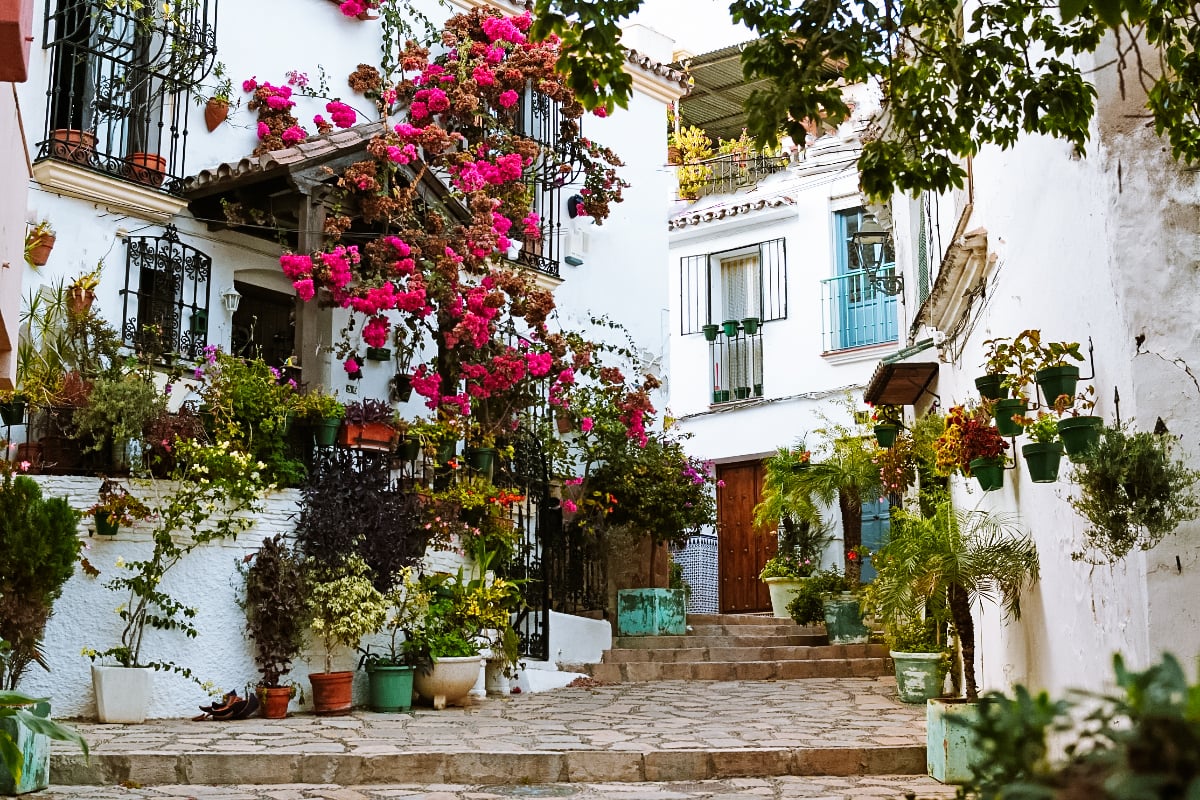
Visit one of the historic cities including Seville, Granada, Córdoba, Ronda, Cádiz or Antequera. Don’t miss the beautiful white villages scattered around the countryside. There are so many to choose from and one is more beautiful than the other. My picks are Frigiliana, Osuna, Mijas, Arcos de la Frontera and Montefrio.
For a relaxing waterside holiday, head to the seaside resorts of Malaga, Marbella or Mojacar, with its hilltop old town and long sandy beach.
How to get to Andalusia
The main airport for Andalusia is Málaga Airport, with direct flights from Prague operated by Czech Airlines and Eurowings (see Costa del Sol for more information).
☞ Here are the best places to visit in Andalusia.
23. Santiago de Compostela
You may have heard of the Santiago de Compostela pilgrimage site in connection with the Way of St James, which ends here at the Santiago de Compostela Cathedral (a UNESCO World Heritage Site).
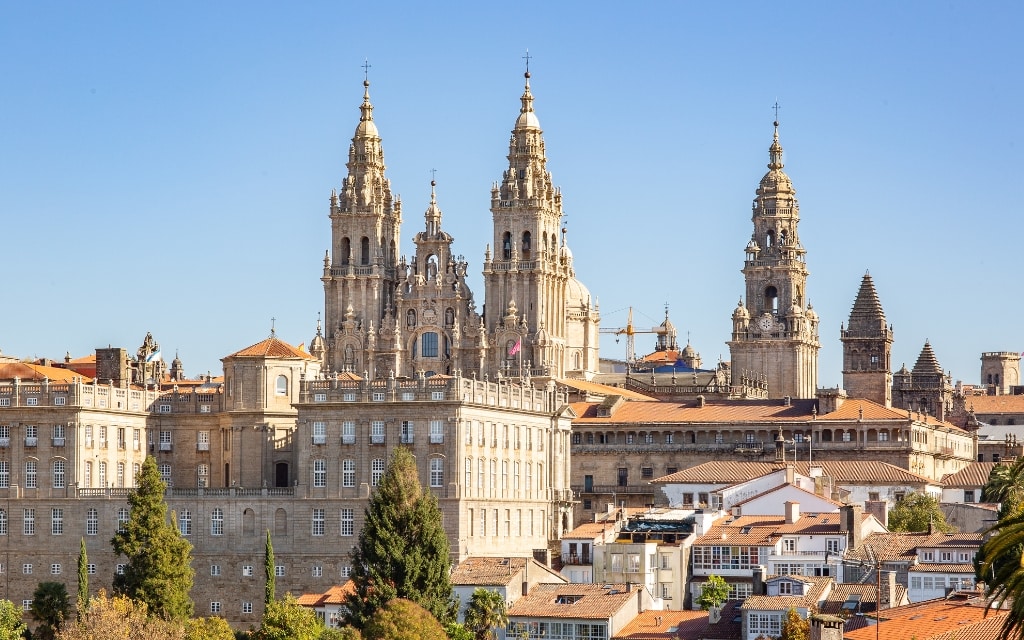
Santiago de Compostela is located in the northwestern part of Spain and is one of the most visited cities in the country. The old core is a labyrinth of streets lined with churches and ornate buildings that are a joy to walk through.
How to get: Santiago de Compostela is the most westerly of all the cities mentioned in Spain. The best way to get here is to fly to Madrid and then take the train to Santiago de Compostela (3-4 hours depending on the train).
24. Faro de Fisterra
Faro de Fisterra represents the symbolic place of the end of the world. Standing here, you get the feeling that there’s only the ocean and nothing else. According to legend, those who visit it are said to receive good fortune and wealth. Maybe that is why it is so popular and whole bus tours come here. 🙂
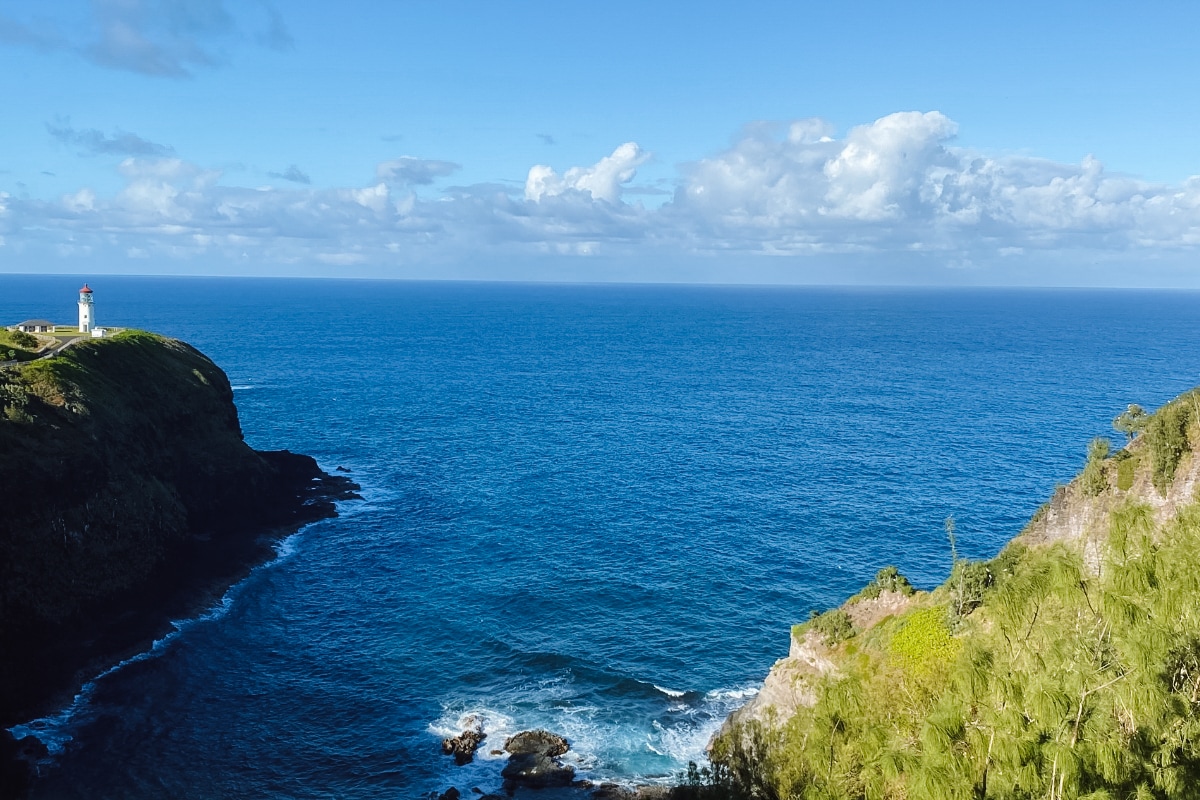
The dominant feature of Faro de Fisterra is the historic lighthouse, which has been an important beacon for sailors since it was built in the 18th century. The surroundings of the lighthouse consist of jagged cliffs, beaches and rocky coves. Near Faro de Fisterra you can visit the charming village of Fisterra.
How to get: Faro de Fisterra is the westernmost place in Spain. The easiest way to get here is by car.
25. Ronda – things to do in Spain
Ronda is a wonderful old Spanish town located in Andalusia. It is considered by many to be one of the most picturesque and romantic cities in Spain. Ronda is literally wedged between beautiful nature, olive groves, citrus orchards and lush vineyards.
The best way to get to know Ronda is to wander the cobbled streets and admire the ancient monuments and magnificent views.
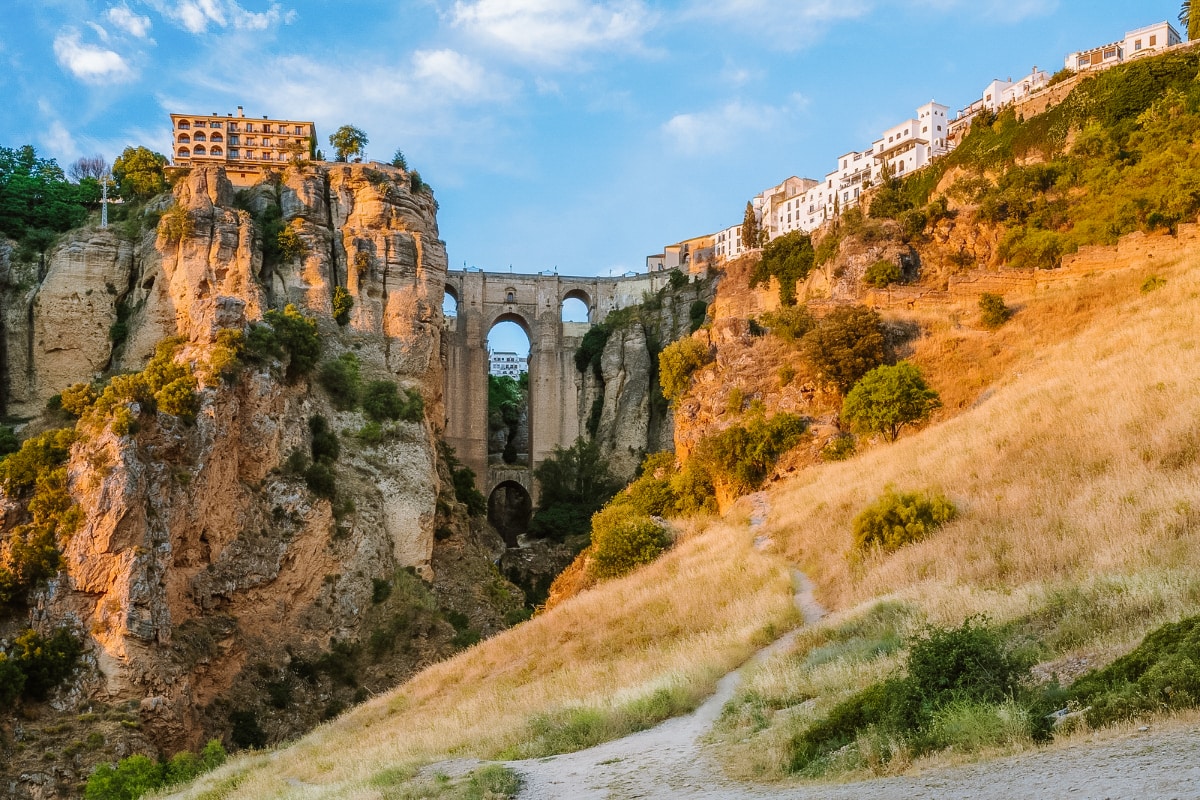
Among the most beautiful sights are the Puente Nuevo (New Bridge), which spans a huge gorge between two cliffs, the Plaza de Toros (Bull Ring) – where bullfights are still held today, the Palacio Mondragon – a palace from the 18th century, which houses the museum, and La Mina, a system of ancient underground tunnels.
How to get to Ronda
Ronda is most easily accessible by car from Málaga (1.5 hours), with direct flights from Prague (Czech Airlines, Eurowings).
A popular option is also a guided trip from Malaga which includes transport to Ronda and Setenil de las Bodegas (see next tip), including admission to Plaza de Toros in Ronda.
26. Córdoba
Córdoba, Spain is located in the southern part of the country, with Seville to the west and Granada to the east. It is a historic city full of Moorish architecture and other monuments from its colourful past. It was once one of Europe’s most important cities and cultural centres.
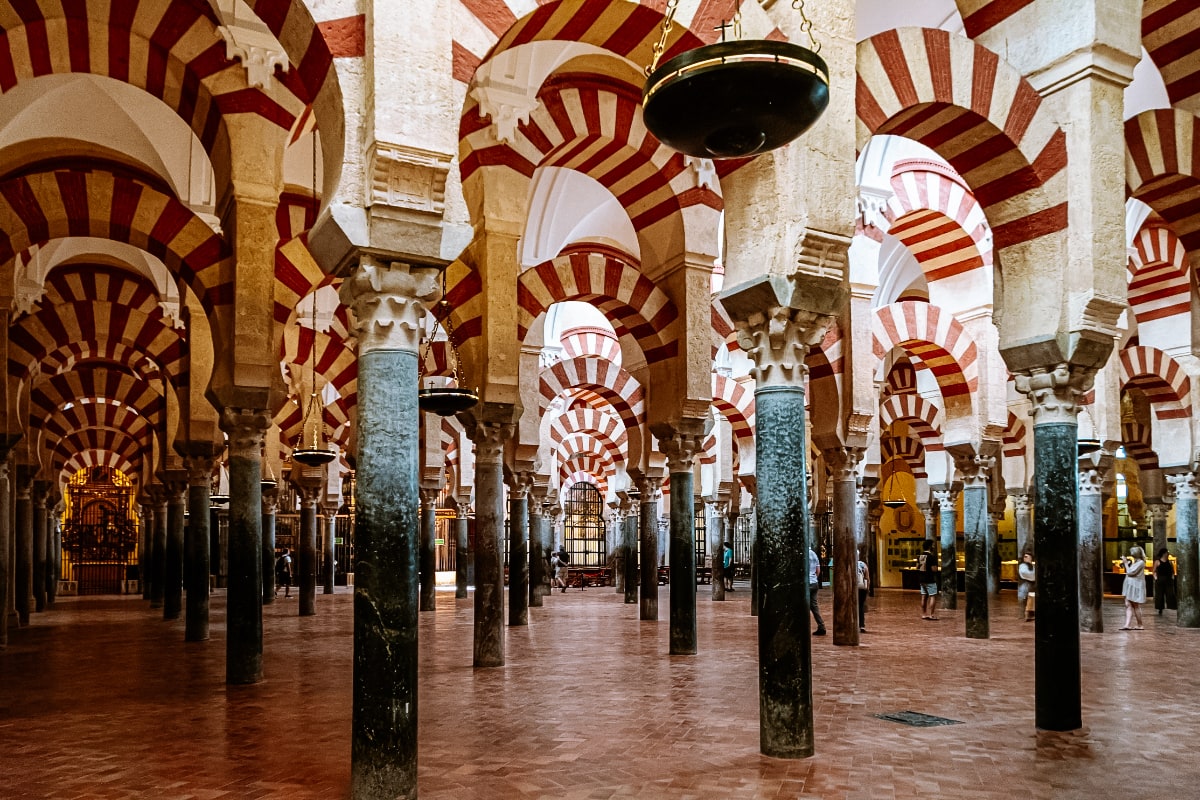
Visit the Alcázar de los Reyes Cristianos (translated as Fortress of the Christian Kings), the Mezquita Mosque-Catedral de Córdoba and the Roman Bridge.
The heart of Córdoba is the sprawling 17th-century Plaza de la Corredera, which is lined with brightly coloured buildings with arcades, restaurants and shops.
How to get: Córdoba train station is an hour from Málaga. By car in 1.5-2 hours.
☞ In our guide to renting and driving a car in Spain, we share practical tips and useful links that will come in handy before your car journey.
27. Cabo de Gata
Cabo de Gata is a nature reserve on the southeast coast of Spain in the province of Almería. It is an isolated area with dramatic landscapes and spectacular seascapes. Thanks to its unique biodiversity and natural beauty, the area has been declared a UNESCO Biosphere Reserve.
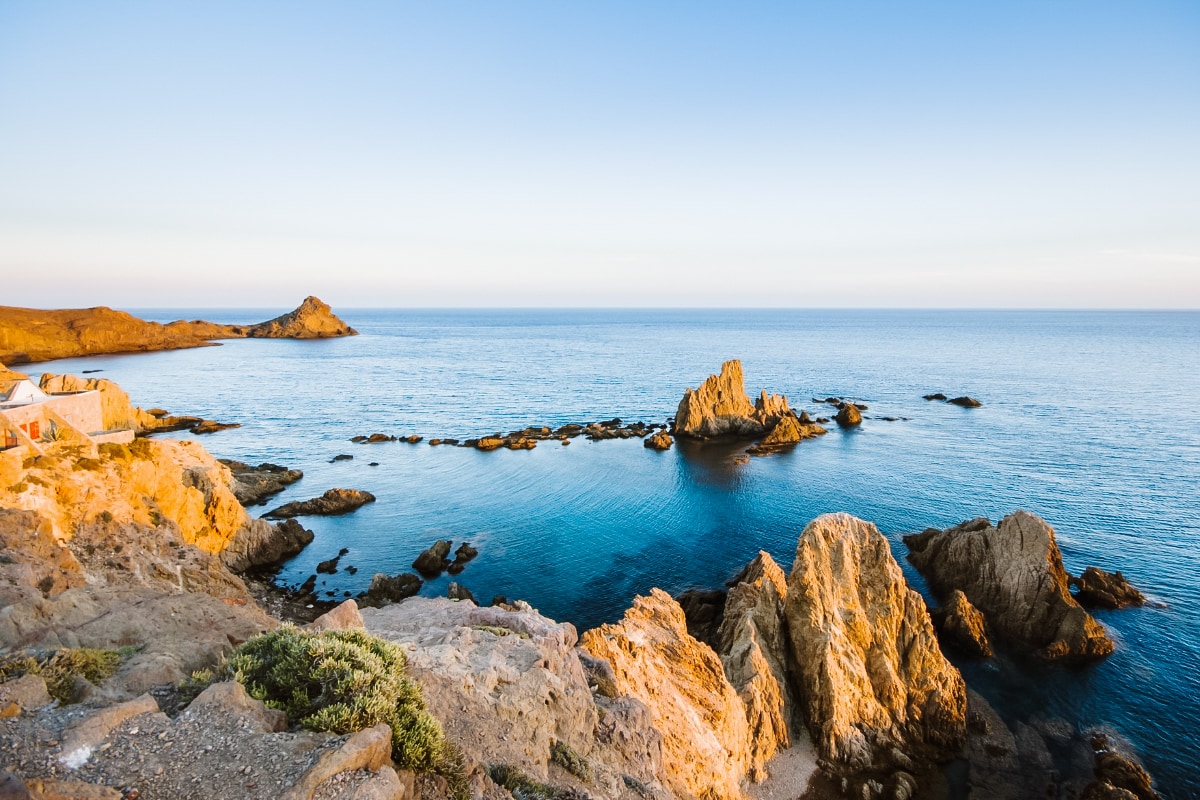
The main attraction of Cabo de Gata is its wild and rugged beauty. The beaches here are some of the most pristine and beautiful in Europe, with clear waters full of marine life. You can explore more than 18 km of coastline including hidden coves, steep cliffs, volcanic rocks and turquoise lagoons.
How to get: Cabo de Gata is east of Málaga, with direct flights from Prague. From Málaga it is best reached by car along the coast (2.5 hours).
28. Altamira Cave
Altamira Cave is located in Cantabria. It is world famous for its spectacular Paleolithic cave paintings, which date back to the older Stone Age period between 18,000 and 14,000 BC. The most famous painting is the “polychrome ceiling”, which depicts a herd of wild bison grazing.
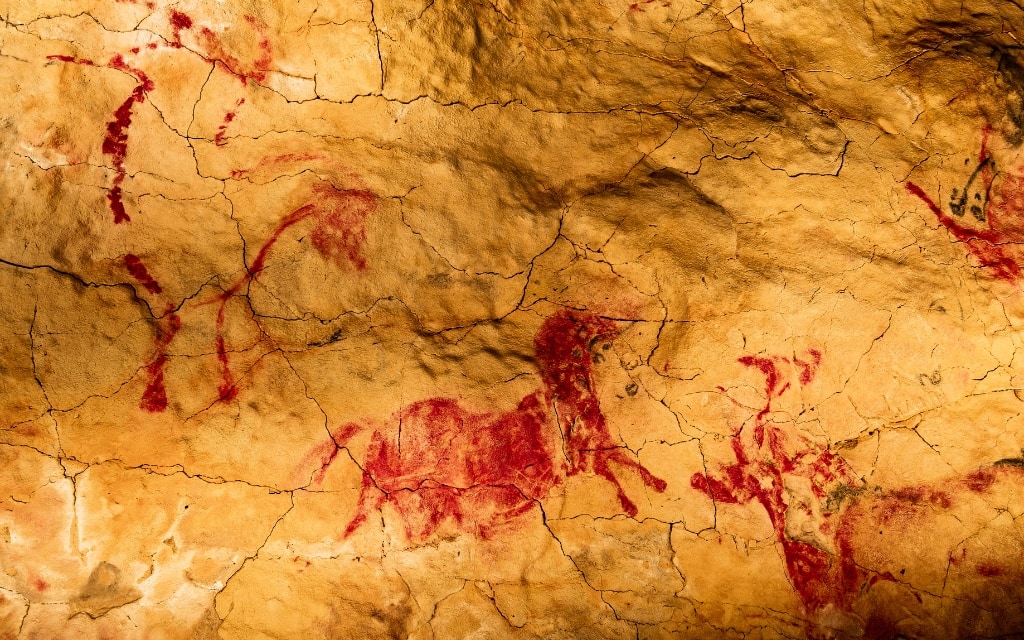
The cave was rediscovered in 1879 by the amateur Spanish archaeologist Marcelino Sanz de Sautuola. Since then, it has been a UNESCO World Heritage Site since 1985.
During the tour you will visit the museum, which is a faithful replica of the Altamira Cave. The original cave is inaccessible to the public.
How to get: Altamira Cave is located 1.5 hours by car from Bilbao (towards the coast of Asturias).
29. Caminito Del Rey
Caminito Del Rey is an epic hiking route near Malaga in Andalusia. The Spanish poet and playwright Federico García Lorca made it famous as “El Caminito del Rey” (The Royal Route). The trail runs along the steep walls of the gorge called El Chorro and offers fantastic views of rocky gorges, deep canyons, wooded ravines and clear water.
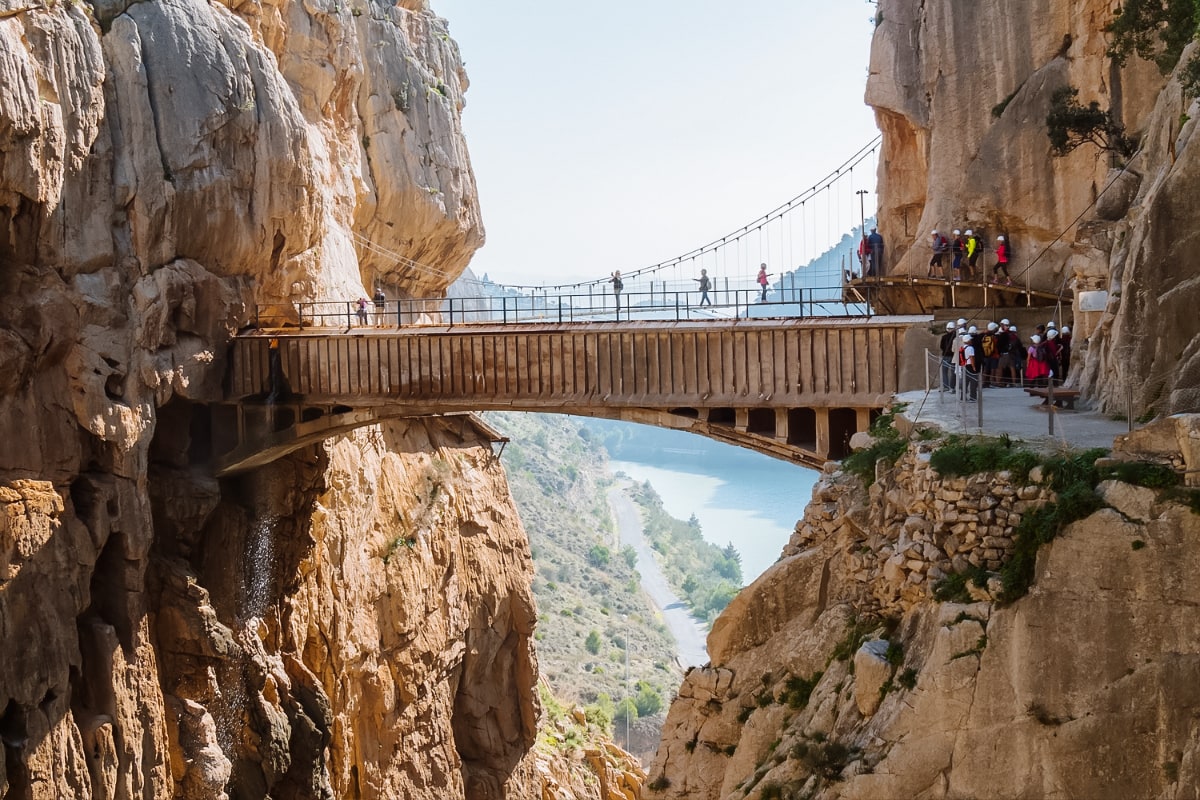
The most impressive part of the trail is the 1 km long section that hangs directly over the El Chorro Gorge at a height of 100 metres above the river. The Caminito Del Rey was considered one of the most dangerous hiking trails in Europe because of its steep cliffs and steep rocks.
However, it has undergone extensive safety modifications in recent years and is now completely safe. And it is rightly one of the best things to visit in Spain.
How to get to Caminito del Rey
The Caminito del Rey is a popular day trip from Málaga and the Costa del Sol. From Málaga there are several train services daily to El Chorro (40-50 minutes). Here you will change to the shuttle bus, which will take you to the entrance of the trail for €2.50 (price for a return ticket; pay cash at the driver).
The bus will take you about 2 kilometres from the trail, from where you will still walk to the northern entrance. At the official entrance you will be given a helmet and instructions. After that, the trail itself, which is one-way, awaits you.
Set aside about an hour from the train before you reach the main entrance to the gorge.
By car you can reach the Caminito del Rey from Málaga in 50 minutes. There are 3 car parks to choose from for a fee of € 2 per day.
The trail itself is perfectly safe and extremely popular. Tickets tend to sell out in advance. There are even a number of
of organized trips
that include entry and transportation.
30. Zaragoza
Zaragoza is a city in the autonomous community of Aragon, northeastern Spain. It is known for its unique blend of Roman and Moorish architecture and vibrant cultural sites. Zaragoza is literally wedged between the beautiful nature of the Pyrenees Mountains.
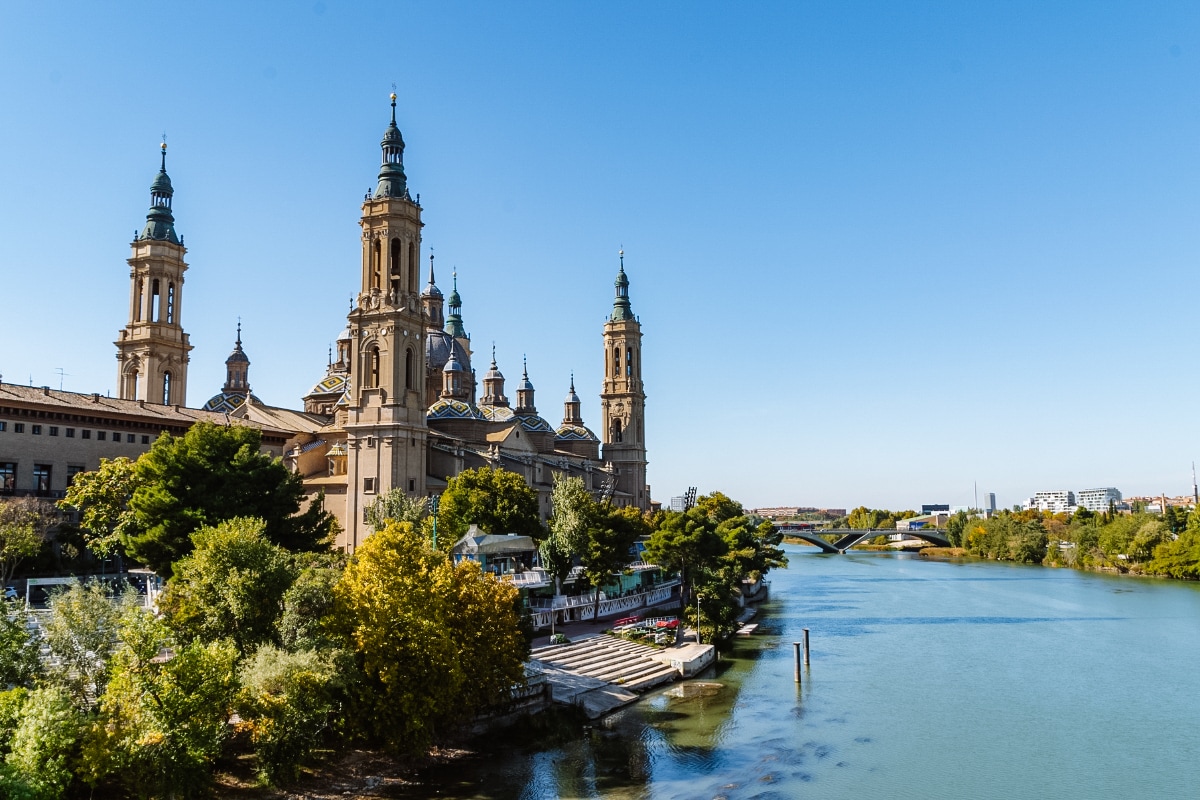
Enter the old town through the stone gate of Puerta del Carmen and walk through the picturesque squares to the Elbro River, where La Seo Cathedral and the colourful domed Basílica del Pilar are a short walk away. Outside the city centre, don’t miss a visit to the UNESCO World Heritage Site, the Moorish Aljafería Palace, now home to the Aragonese Parliament.
How to get: Zaragoza is halfway between Barcelona and Madrid. It takes 1.5 hours to get here by train from both cities.
31. Pyrenees
The Pyrenees is one of the most stunning and diverse areas to visit in Spain. It is located in the north of the country along the border with France. In the Pyrenees, you’ll enjoy fantastic views and plenty of outdoor activities, from lush valleys to high peaks.
The Pyrenees are ideal for mountain biking, ski mountaineering, snowshoeing or simply exploring the mountains on foot.
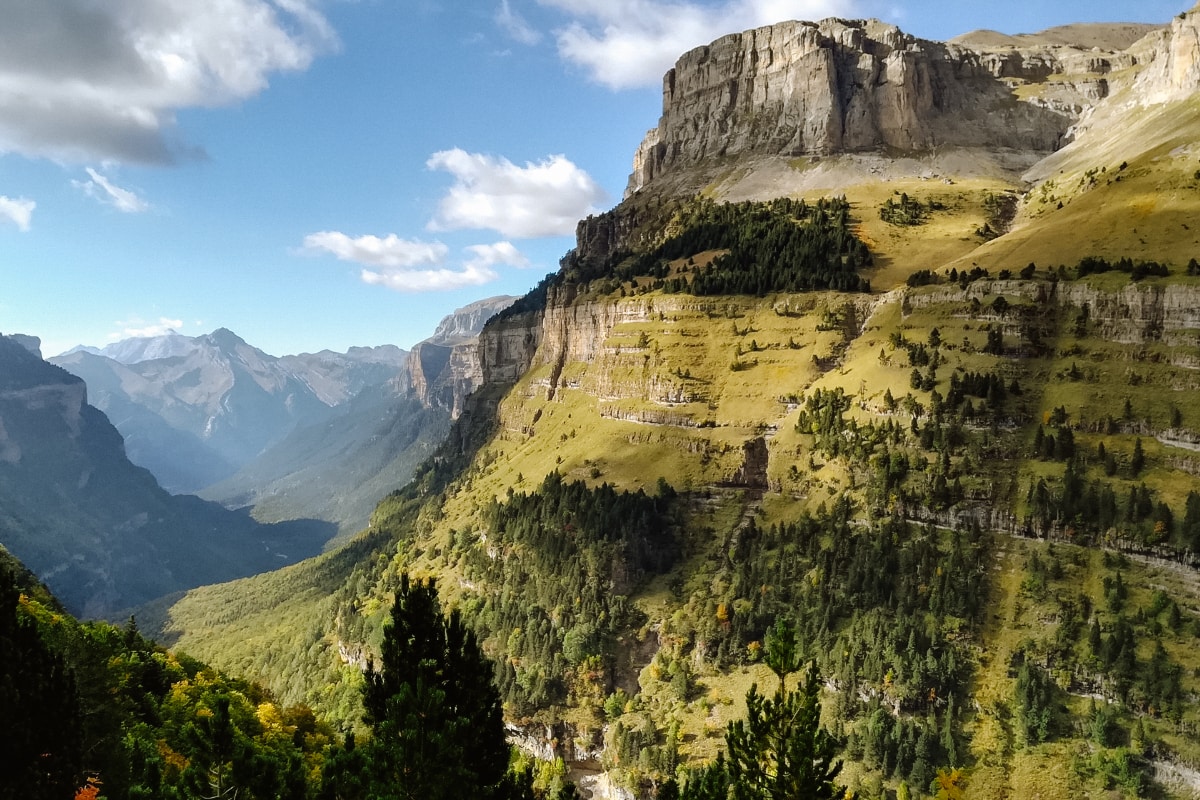
Some of the best places to visit are the Ordesa National Park with its spectacular rock formations known as the “tosca”, the Posets-Maladeta Nature Reserve, which includes both lowland and high mountain areas, Monte Perdido with its many glacial lakes and the Barrancs de Boí, a stunning gorge full of waterfalls.
How to get: The Pyrenees line the Spanish-French border. A car is the best way to experience as much of the Ordesa Mountains and National Park as possible.
32. Costa Brava
The Costa Brava is a beautiful coastline in the north-east of Spain. It stretches from Blanes to Portbou and is famous for its picturesque beaches, stunning cliff tops and crystal clear waters.
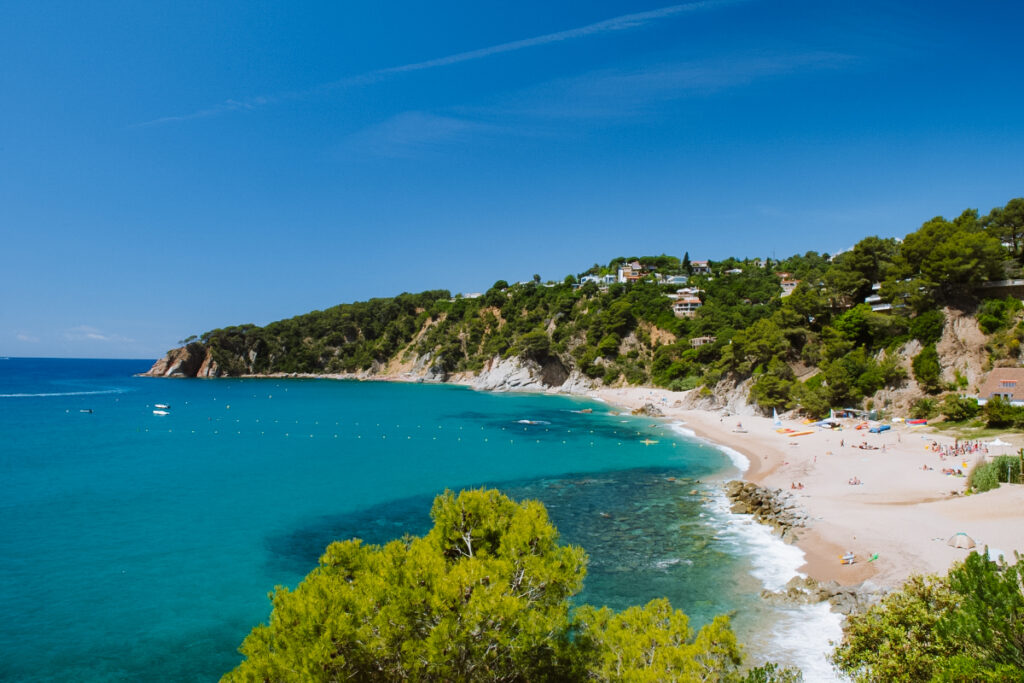
On Costa Brava, you can practice water sports, snorkel, discover historical monuments, taste delicious cuisine or discover beautiful coves. In addition, the climate is mild all year round. All this makes Costa Brava one of the most visited areas in Spain.
How to get: Costa Brava is north of Barcelona, from which it is also the easiest to reach. Right in the Spanish Square, you can hop on a train that will take you to the towns along the coast. The time varies depending on which resort you are going to – from 30 minutes to about 2 hours. The northernmost resorts are better visited by car.
33. Mallorca – the best places to visit in Spain
Mallorca (or Majorca) is the largest of the Balearic Islands in Spain and is a popular holiday destination that attracts millions of visitors each year.
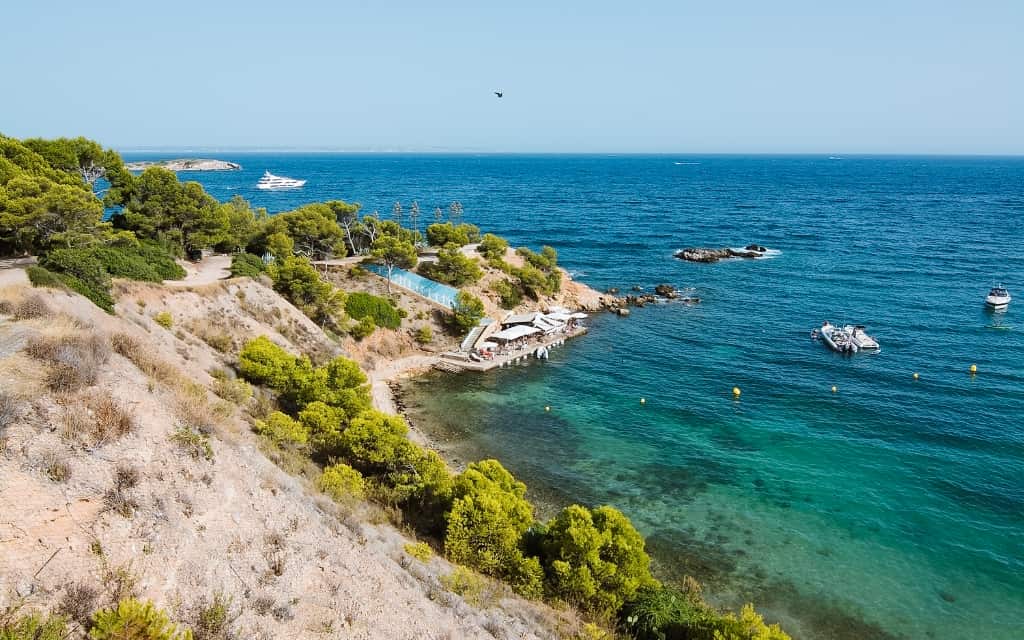
Enjoy relaxing on beautiful beaches, diving or water sports. Or follow one of the hiking trails through the diverse landscape.
How about following in the footsteps of an earlier history that is influenced by Roman, Moorish and Christian influences? You can end the day in a traditional restaurant, where you will be treated to local cuisine. Or in a bar with a lively atmosphere.
How to get to Mallorca
The direct flight from Prague to Palma de Mallorca takes 2 hours and 30 minutes. The airlines to choose from are:
- Czech Airlines – Traditional Czech airline that flies almost all year round (in the winter season the offer of flights is limited). The ticket price also includes hand luggage up to 8 kg.
- Eurowings – German low-cost airline that flies in high season and offers different times than Czech Airlines. The price of the basic ticket includes a small baggage with a maximum size of 40 x 30 x 25 cm – the parameters meet, for example CabinZero (28 l) .
If the date doesn’t suit you, here you can search for flights with a transfer .
☞ Get inspired by the best things to do in Mallorca including a travel guide.
Best Things to do in Spain – Map
HOW TO USE THIS MAP: Above you will find a detailed map with tips on the best things to do in Spain. Click at the top left of the map to see separate layers with highlighted locations. You can hide and show the different layers or click on the icons on the map to see the names of the places I mention in the Spain guide. If you want to save the map, star it. For a larger version, click on the icon in the upper right corner.
What to taste in Spain? What is the national food of Spain and what do Spaniards drink?
If you want to get a full taste of Spain, you should try the national dish, paella. This is a traditional rice dish made with chicken, rabbit and snails, seasoned with saffron and spices. The most popular version is paella with seafood.
Another essential element of Spanish cuisine that should not be missed are the tapas. Bars all over Spain serve an endless variety of tapas; from olives and cured meats to fried calamari or stuffed peppers.
Among Spanish drinks, beer (cerveza) leads the way. Spaniards also enjoy wine (vino), sangria (a mixture of wine, brandy and wine) and brandy.
How to get around Spain?
Trains and buses
Getting around Spain is relatively easy, as many destinations can be reached by an extensive network of trains, buses and ferries.
Spain’s Renfe train network is the main mode of long-distance transport in the country and connects most major cities. There are several different types of trains available, from regional trains to the high-speed AVE trains, which reach speeds of up to 300 km/h (making them some of the fastest trains in Europe). Tickets can be purchased online for most routes.
Another popular way to explore the country is by bus, with national bus companies such as Alsa and Avanza connecting even more small towns and villages than the railways. Local bus routes tend to be cheaper than trains, although the journey usually takes longer. You can buy tickets at the station or online.
On Omio.com you can find bus and train connections in one place (especially for longer distances).
For those wishing to explore Spain’s coastal islands, ferries are available from many cities on the mainland.
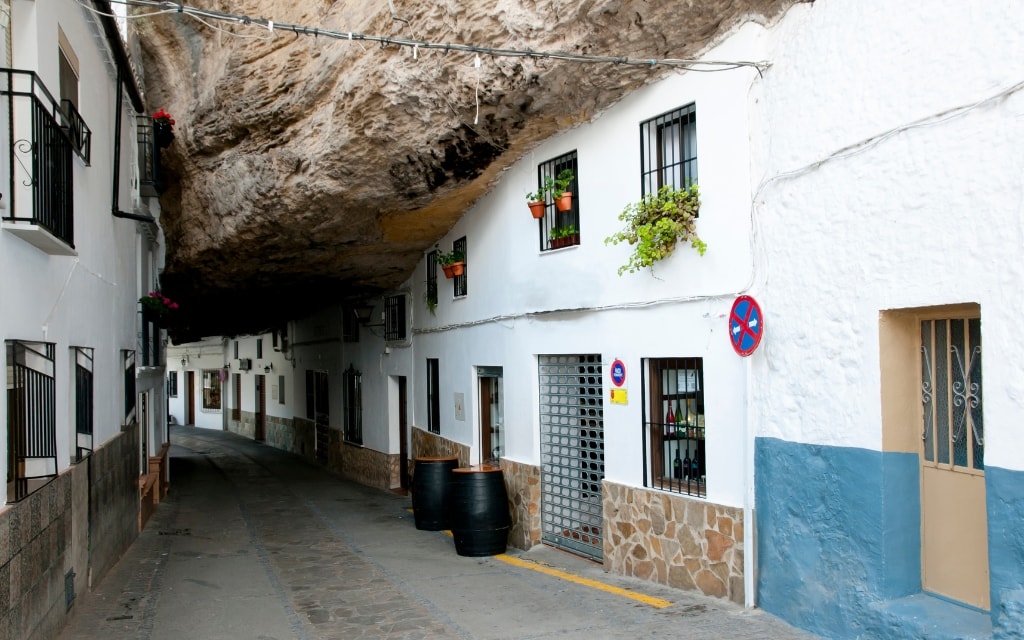
Car rental in Spain
Would you rather explore Spain on your own? Rent a car is one of the most popular ways to explore the most beautiful places in Spain and discover corners of the country you wouldn’t be able to reach by public transport.
Renting a car is easy. The basic rule of thumb is to book well in advance (especially if you want a car with an automatic transmission). Just fill in the details and show your ID and driving licence (from your home country for EU/EEA nationals) when you collect it. The price also includes insurance and free cancellation.
☞ In our guide to renting and driving a car in Spain, we share practical tips and useful links that will come in handy before your car journey.
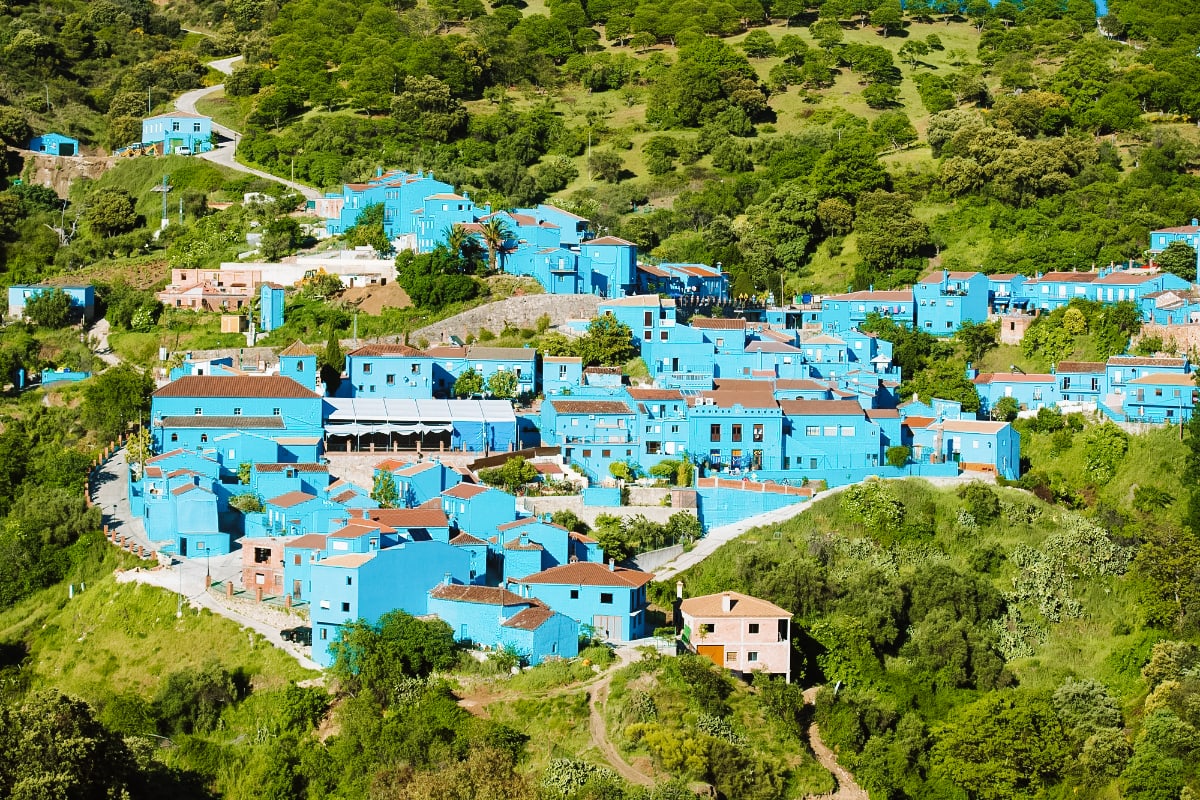
Plan your trip quickly and easily. If you buy something through our links, we get a small commission. You pay nothing extra. Thank you!
These were our tips on things to do in Spain. Do you have a question? We’ll be happy to answer it in the comments below. Have a safe journey!
More information about Spain
MADRID: Get inspired by our tips on the best things to do in Madrid.
BARCELONA: Barcelona is the most visited city in Spain, along with Madrid. Check out tips on the things to do in Barcelona (entrance fees, opening hours, photos, map) or plan your trip with the Barcelona in 3 Days itinerary.
VALENCIA: Valencia is another beautiful city in Spain. We’ve put together a complete guide to visiting Valencia, including tips on the best things to do in Valencia.
ANDALUSIA: Andalusia is one of the most beautiful regions in Spain – in our Andalusia guide, we’ve put together tips on the best places to see in Andalusia. The most popular seaside resort in Andalusia is Málaga.
GRANADA: Granada is a historical gem, home to the world-famous Alhambra Palace. Read more our tips on the best things to do in Granada.
SEVILLA: Seville is one of the most beautiful cities in Spain – here’s a guide and tips on the best things to do in Seville.
MALLORCA: Mallorca is one of the most beautiful islands in Spain, with so many breathtaking places to visit in Mallorca.
